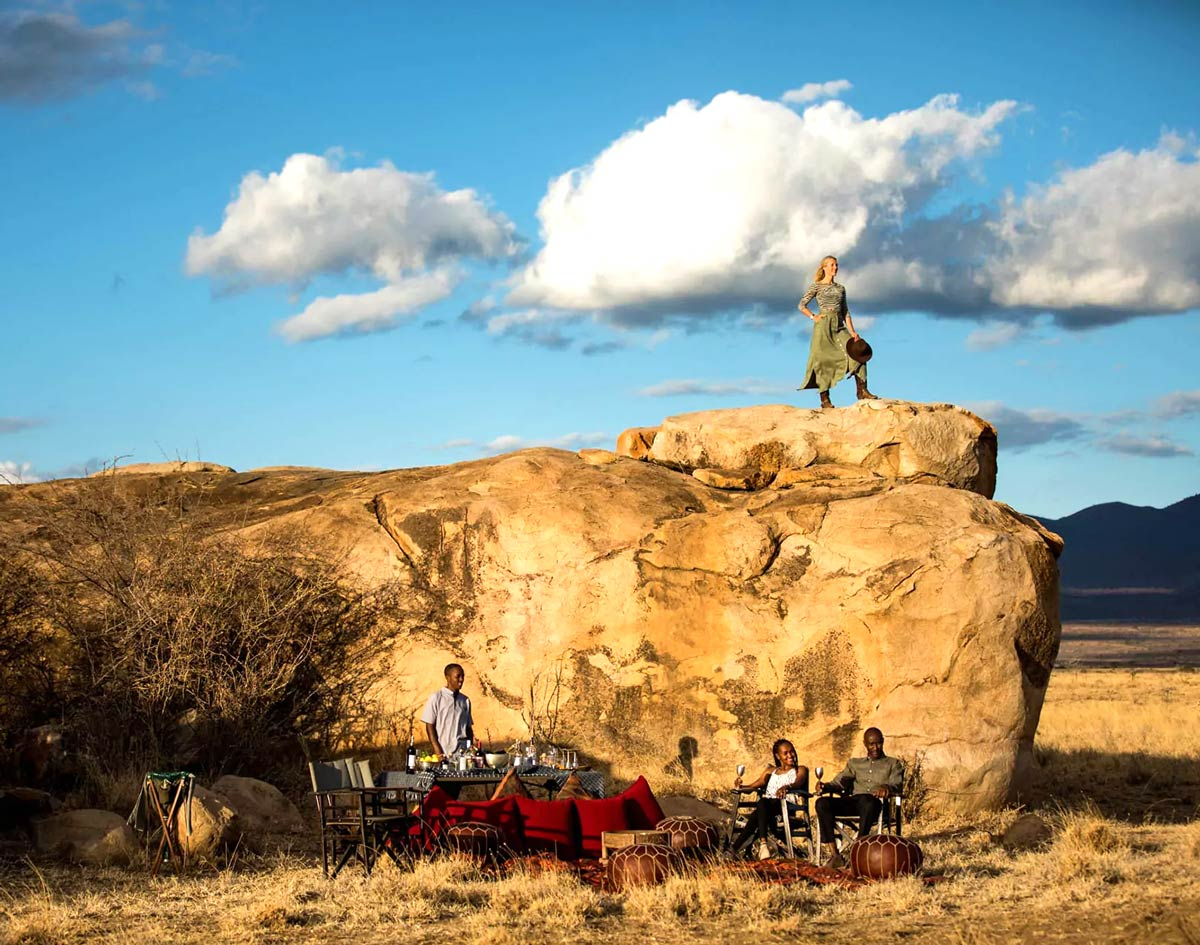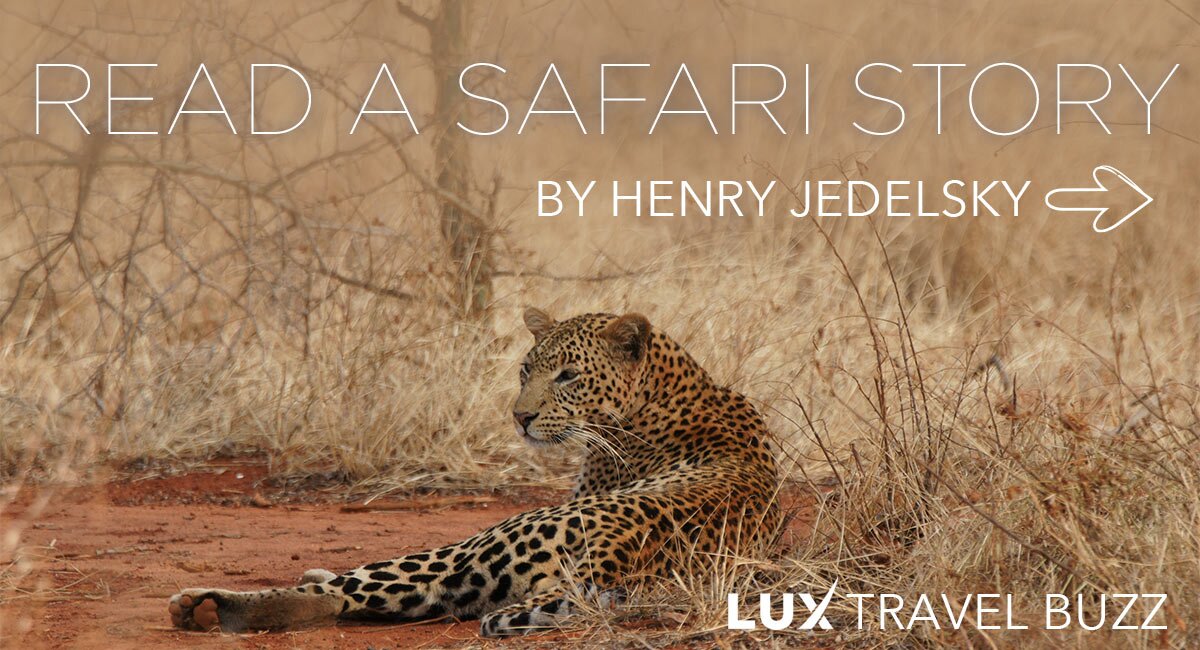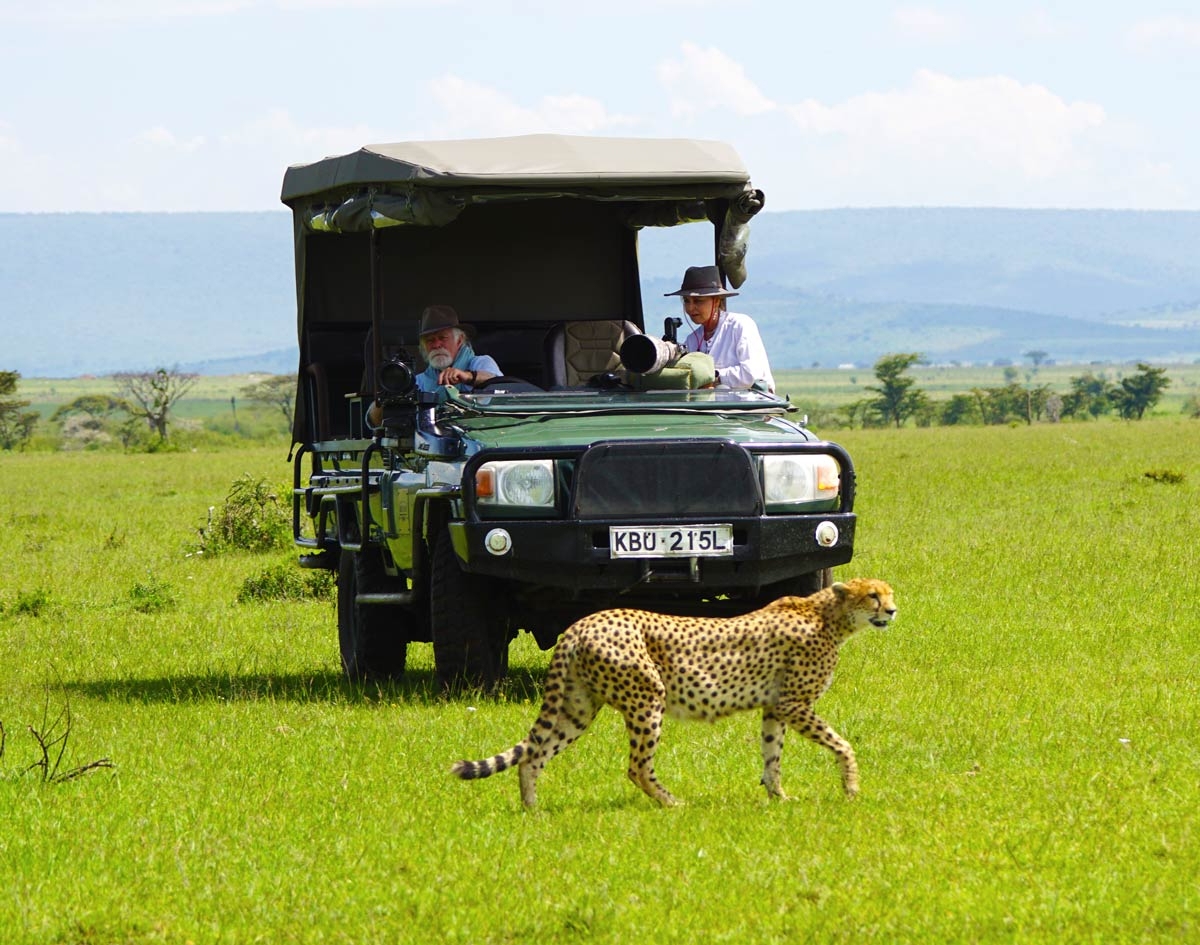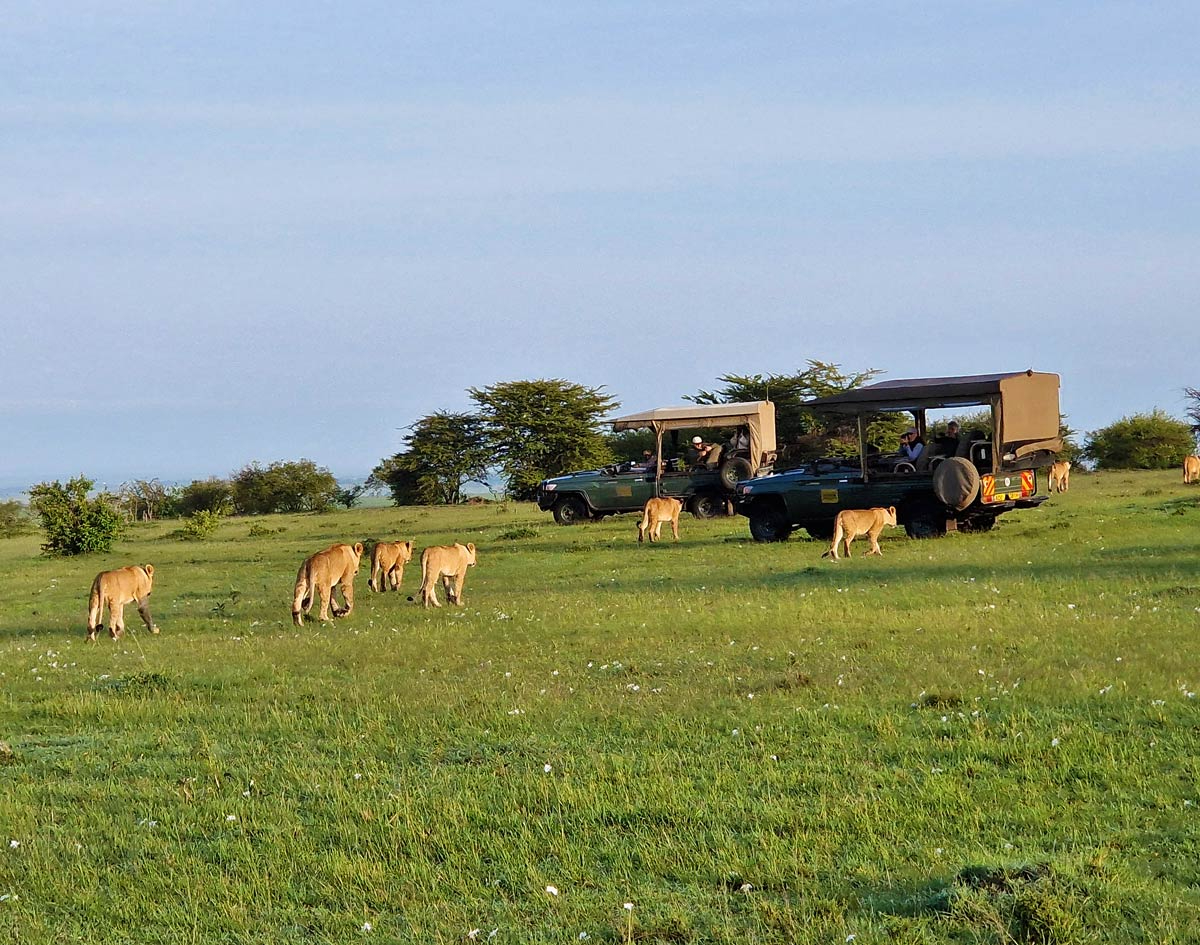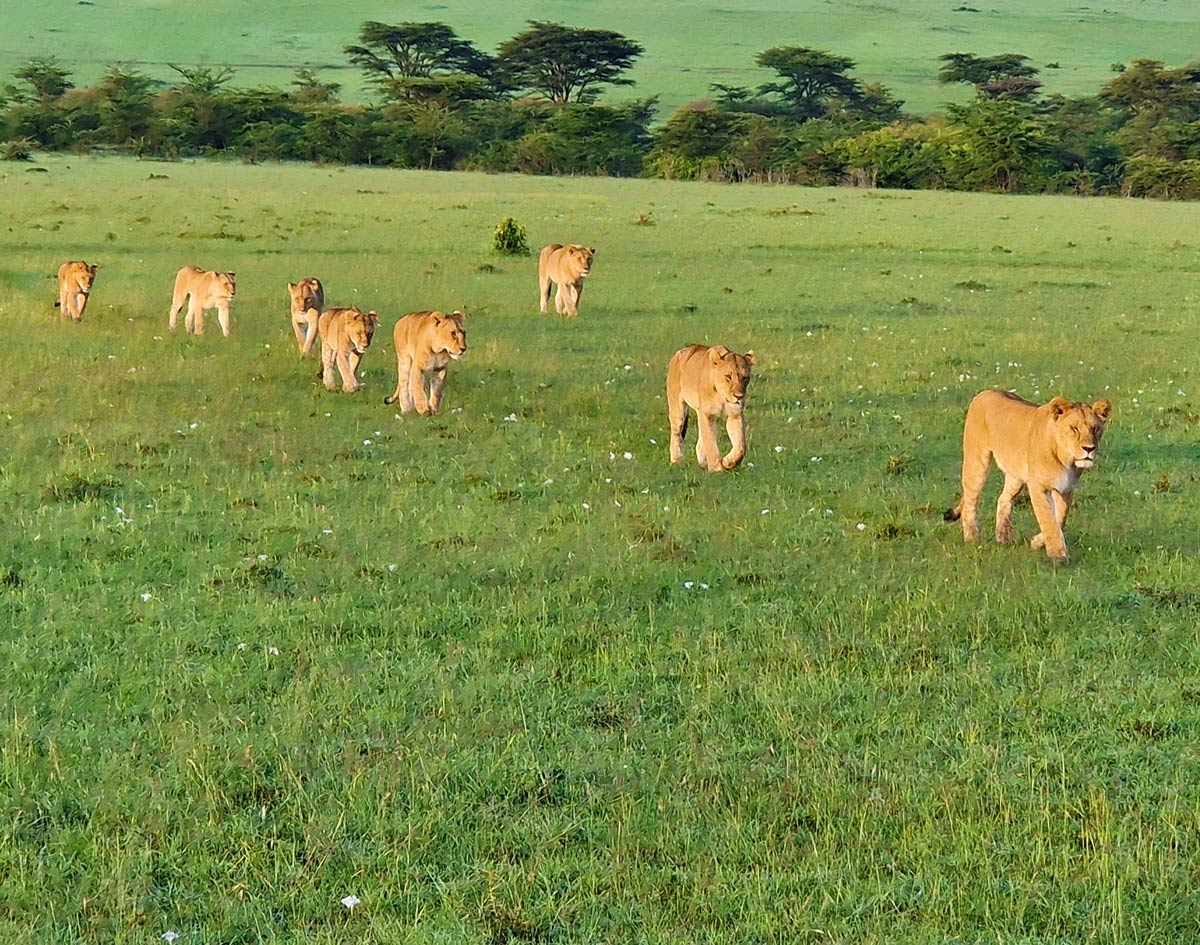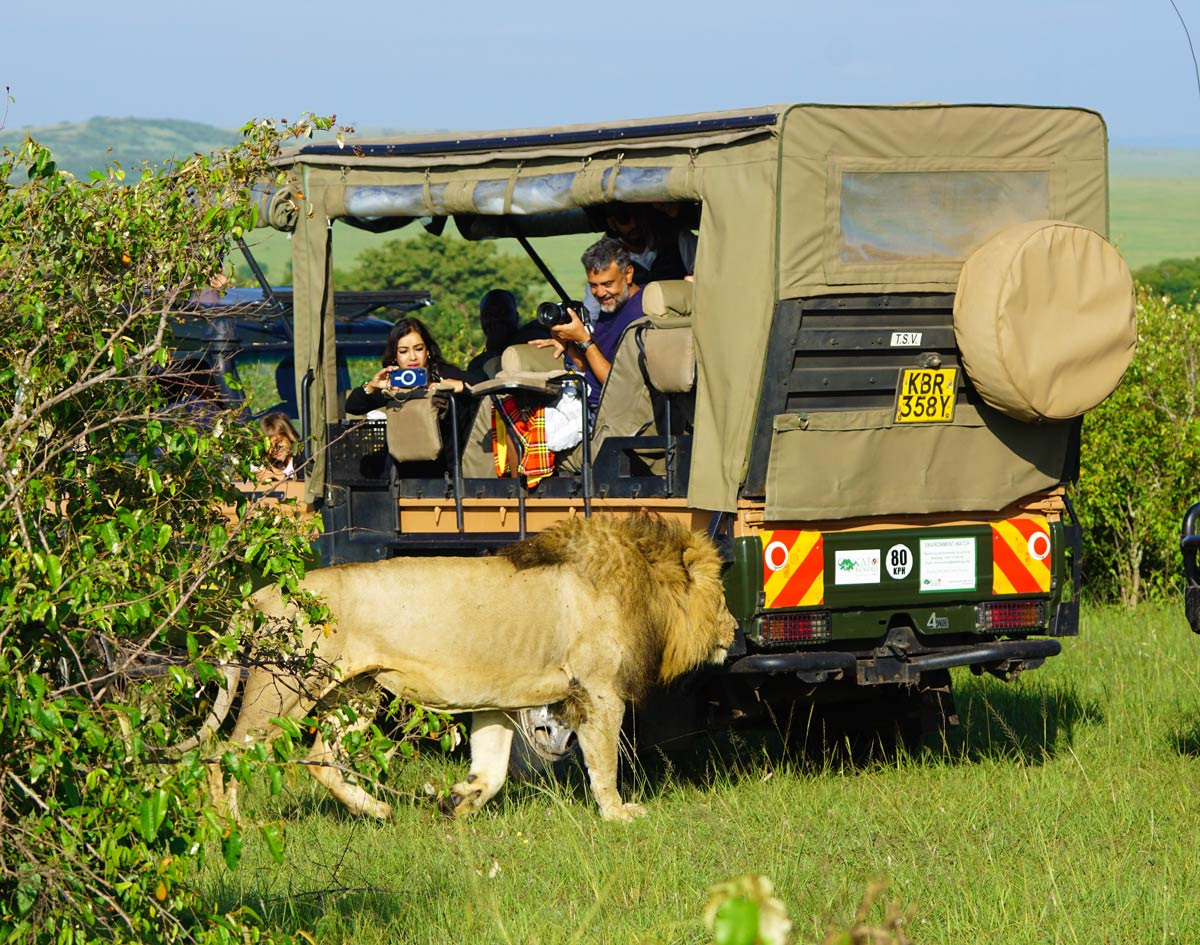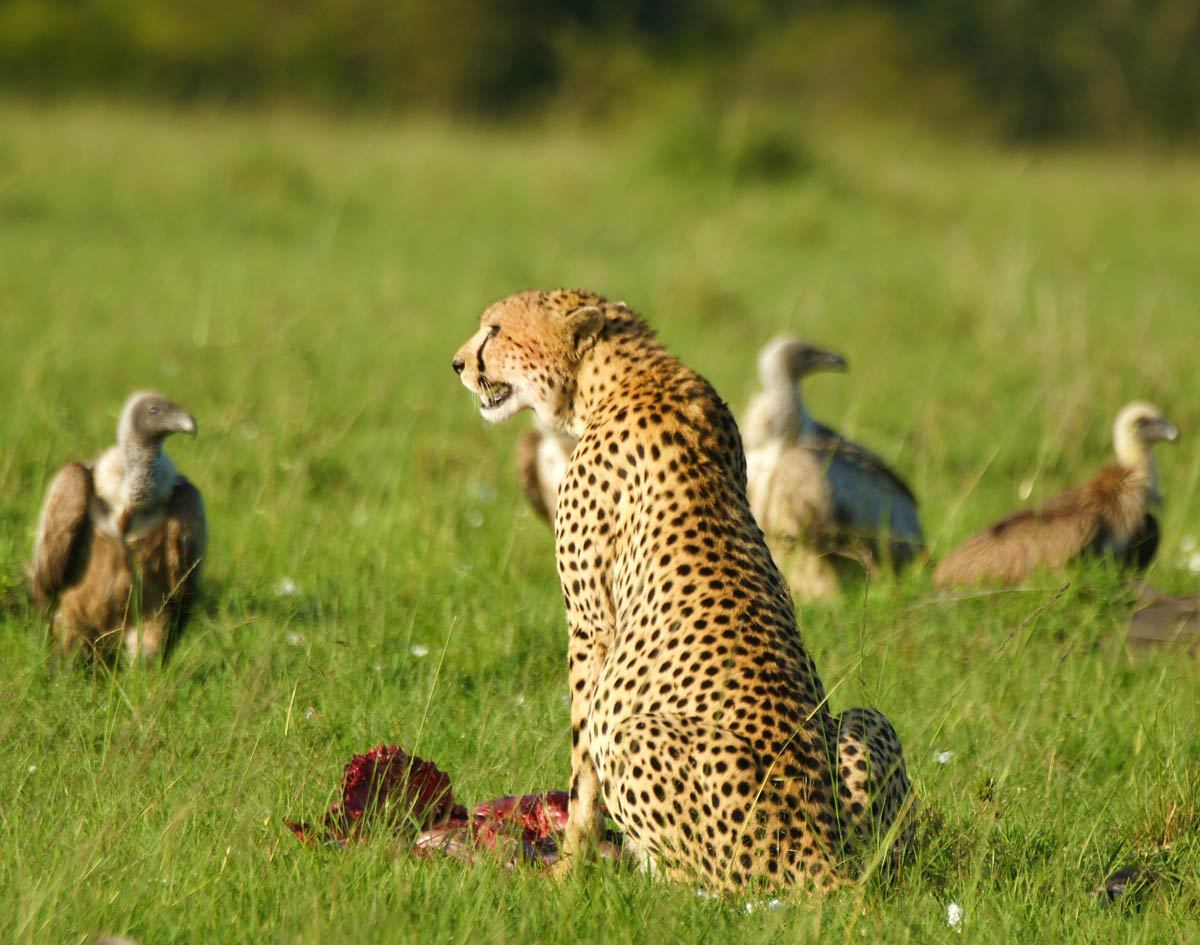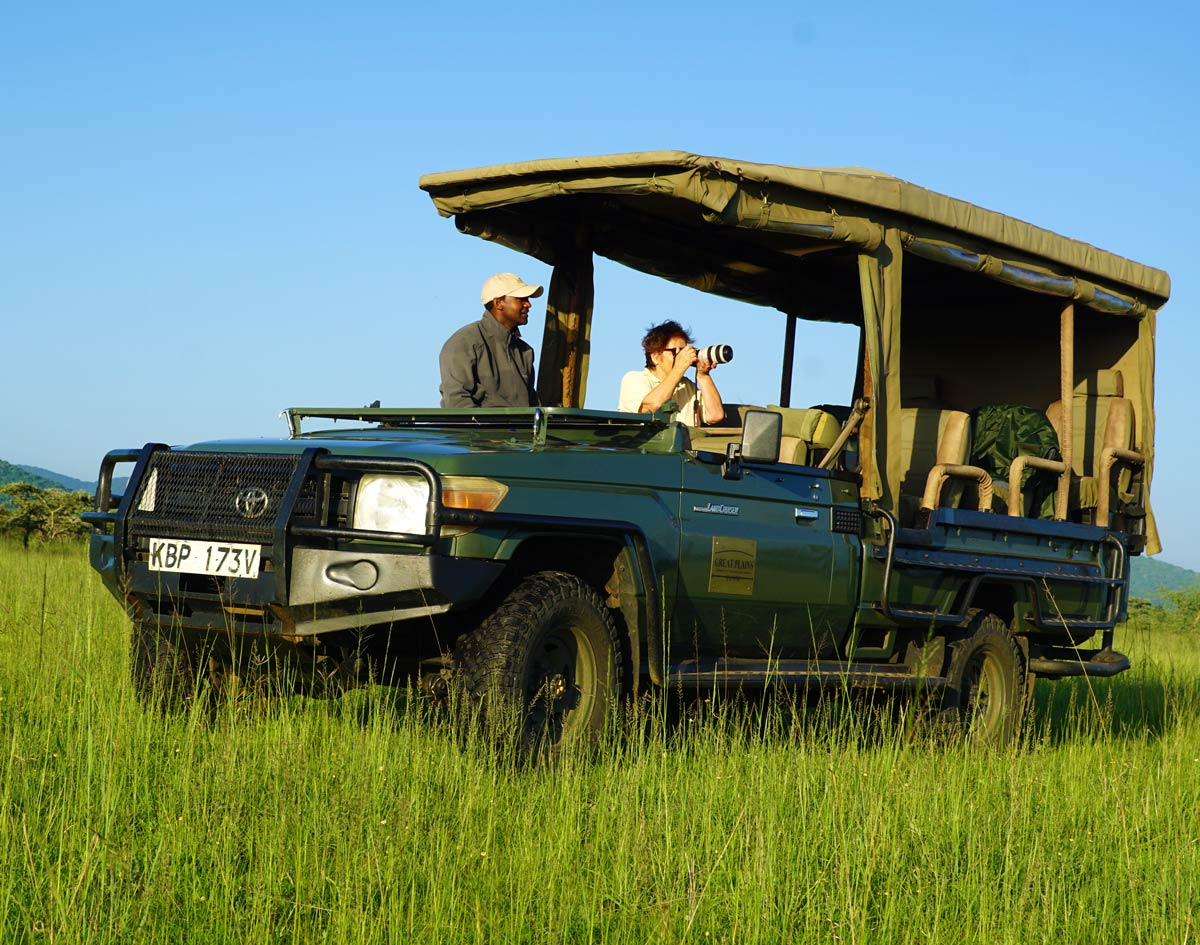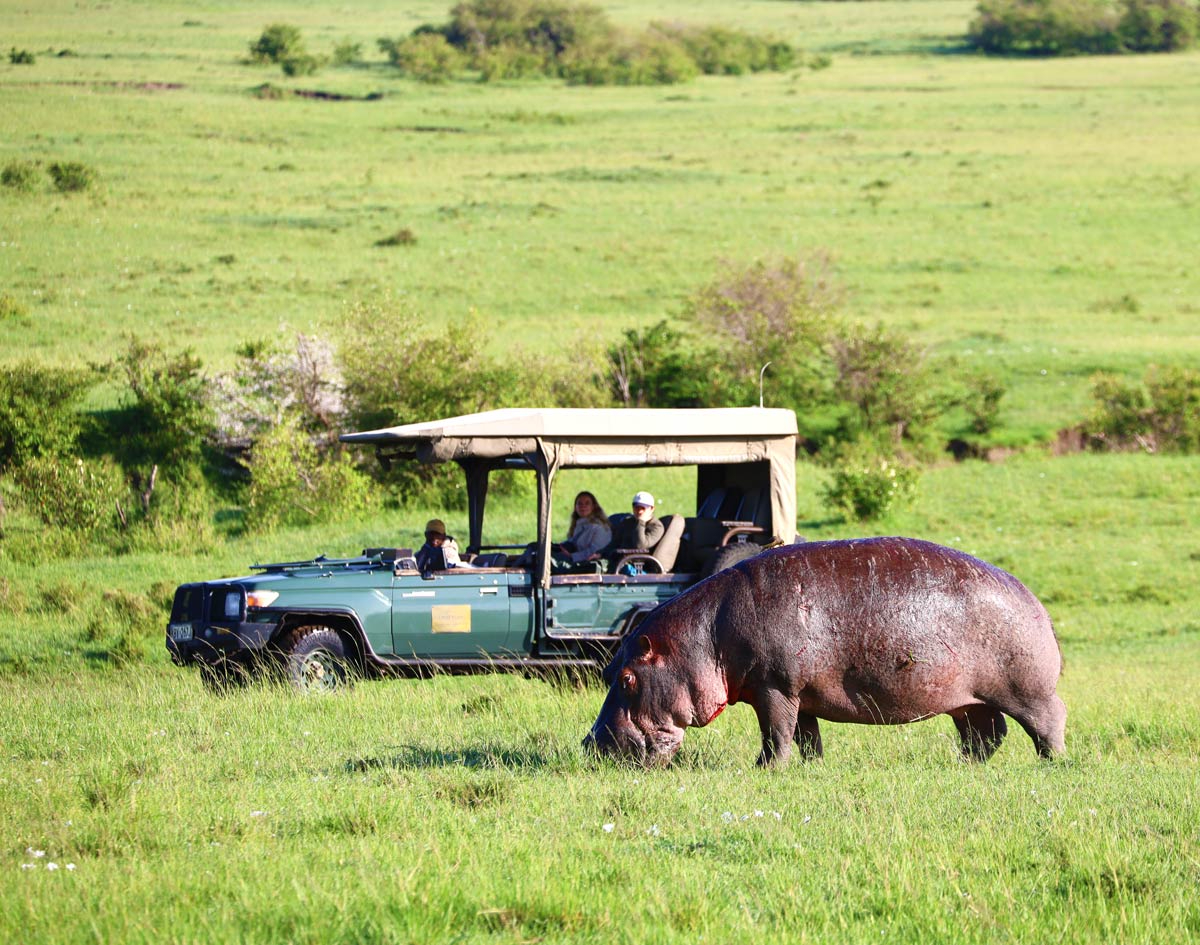
Safari Adventures in Africa: Unforgettable Experiences
Did you know that the term "safari" originates from Swahili, the primary language of East Africa, translating to "journey" or "trip" and traces its roots back to the Arabic word "safar" with a similar meaning? In regions where Swahili is spoken, it signifies any form of travel or expedition.
What's fascinating is that the first safaris were not focused on wildlife viewing, but rather on exploration, hunting, and adventure. It wasn't until the late 19th century that the focus shifted towards observing and appreciating the incredible African wildlife.
Believe it or not, during a safari Theodore Roosevelt, the 26th President of the United States was attacked by an elephant. Roosevelt fired at the elephant multiple times to defend the group, but the animal charged. In an intense moment, the elephant was stopped just a few feet away. This event added to his reputation as a fearless adventurer.
What's fascinating is that the first safaris were not focused on wildlife viewing, but rather on exploration, hunting, and adventure. It wasn't until the late 19th century that the focus shifted towards observing and appreciating the incredible African wildlife.
Believe it or not, during a safari Theodore Roosevelt, the 26th President of the United States was attacked by an elephant. Roosevelt fired at the elephant multiple times to defend the group, but the animal charged. In an intense moment, the elephant was stopped just a few feet away. This event added to his reputation as a fearless adventurer.
Kenya ol Donyo Lodge
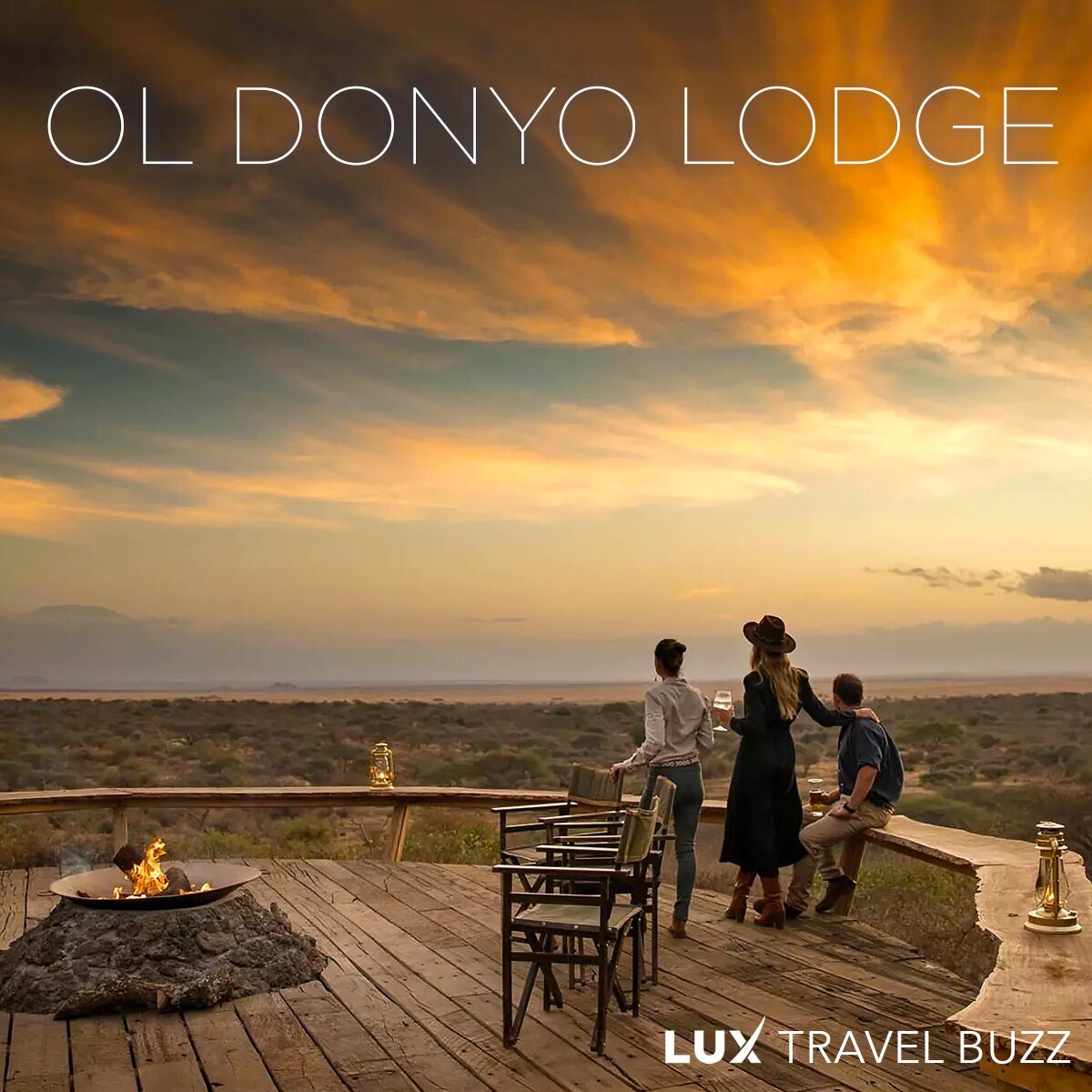
© Image: ol Donyo Lodge
Ol Donyo Lodge Kenya
:
Nov 26
69°F / 21°C
Where the Chyulu Hills stretch out to meet the plains of Kenya's Amboseli, a private wilderness unfolds where time seems to stand still…
Perched on a log at ol Donyo Lodge, I sat wrapped in the sounds of the wilderness, elephants rumbling a stone's throw away. It was almost meditative. I joked about swapping the usual spa music for this natural symphony during a Great Plains massage when suddenly, I felt an elephant gently tap my leg with its trunk. In that moment, the magic of ol Donyo Lodge came alive, reflecting the essence of safari moments that stay with you forever.
Perched on a log at ol Donyo Lodge, I sat wrapped in the sounds of the wilderness, elephants rumbling a stone's throw away. It was almost meditative. I joked about swapping the usual spa music for this natural symphony during a Great Plains massage when suddenly, I felt an elephant gently tap my leg with its trunk. In that moment, the magic of ol Donyo Lodge came alive, reflecting the essence of safari moments that stay with you forever.
The Lodge
On the Mbirikani Group Ranch—a sprawling expanse of wild Africa owned by 4,000 Maasai and bordering the Chyulu Hills National Park—ol Donyo Lodge is a testament to the fusion of contemporary design and rich Maasai culture, setting the stage for an unforgettable Kenyan safari. Nestled in over 111,000 hectares of private land straddling Kenya's Tsavo and Amboseli National Parks, ol Donyo Lodge is carved from ancient lava rock from Kilimanjaro. The property, perched on a hillside, offers panoramic views of East Africa’s classic savannahs stretching out towards Mount Kilimanjaro. Here, timelessness isn't just a feeling—it's palpable in every stone and vista.
Lodging in the Lodge
The lodge features 8 Deluxe Suites and a two-bedroom Sambu Suite, perfect for families. Each suite at ol Donyo Lodge is a portal to the soul of East Africa. With views over the plunge pools and across to Kilimanjaro, the suites’ star beds offer a night under the stars, where you can drift off to the sounds of hyenas and lions prowling in the distance.
Gourmet Dining
Being part of the exclusive Relais & Châteaux group, ol Donyo Lodge is committed to exceptional dining, wine selection, and service. It’s not just about seeing wildlife; it's about experiencing the 'Great Plains Conservation style'—a seamless blend of luxury, adventure, and a warm welcome that makes you feel like part of the family.
Breathtaking Experiences
The lodge offers a range of experiences from horseback safaris to mountain bike treks, guided walks, and open vehicle drives, each designed to immerse you in this untouched paradise. Guided safaris, whether on foot, by bike, or on horseback, open up the conservancy in ways only a few ever experience, returning to exceptional meals prepared by our Executive Chef.
The newly enhanced sunken hide by the waterhole is a standout feature, offering guests the rare opportunity to spend a day, or even a night, in close communion with the wild, watching as animals come to drink under the cover of darkness.
The newly enhanced sunken hide by the waterhole is a standout feature, offering guests the rare opportunity to spend a day, or even a night, in close communion with the wild, watching as animals come to drink under the cover of darkness.
Community Support
Dereck Joubert, CEO of Great Plains Conservation, emphasizes the lodge’s role in community and conservation efforts. “Our partnership with the community extends beyond lease payments to support teachers and scholars, and our projects in wildlife conservation and tourism are designed to uplift our communities.” He adds that the tourism dollars spent at ol Donyo help fund collaborative conservation efforts, boasting success stories with lions, cheetahs, and the iconic bull elephants—one of Africa's last large tuskers.
African Horse Safari
Our stables are home to a diverse herd of 20 horses ranging from 15.1hh to 17.1hh, including majestic Friesian and Shire crosses, spirited Arabians, and the robust South African Boerperd. Selected for their calm demeanors, endurance, and adaptability, our horses are the ideal companions for your safari adventure, well-schooled and acclimatized to the wildlife we share our home with. Strap in for a pulse-racing African horse safari at ol Donyo Lodge, where the untamed landscapes of Africa unfold beneath the hooves of our trusty steeds.
Gear up for a 2 to 4-hour ride exploring the breathtaking terrain that surrounds ol Donyo Lodge. Perfect for those with a bit of experience, these rides feature exhilarating medium to fast-paced canters that get your heart racing as you come face-to-face with the region’s famous big Tuskers. To join, you'll need to be riding fit, confident, and capable of handling an easy horse across varied and challenging terrains. If you're less experienced, opt for our gentler 60 to 90-minute rides across the open plains. Ideal for novices, this experience offers a serene way to soak in the vast landscapes on horseback, with a bit of instruction and a short trot to get you comfortable in the saddle.
Gear up for a 2 to 4-hour ride exploring the breathtaking terrain that surrounds ol Donyo Lodge. Perfect for those with a bit of experience, these rides feature exhilarating medium to fast-paced canters that get your heart racing as you come face-to-face with the region’s famous big Tuskers. To join, you'll need to be riding fit, confident, and capable of handling an easy horse across varied and challenging terrains. If you're less experienced, opt for our gentler 60 to 90-minute rides across the open plains. Ideal for novices, this experience offers a serene way to soak in the vast landscapes on horseback, with a bit of instruction and a short trot to get you comfortable in the saddle.
Great Plains Conservation is setting new standards with its camps and lodges in Botswana, Zimbabwe, and Kenya. Our Africa specialists, Elisabeth and Henry Jedelsky, were invited to Kenya and met two African celebrities. Read the Story >>
Dream with Us
More of our fantastic Camps in Kenya
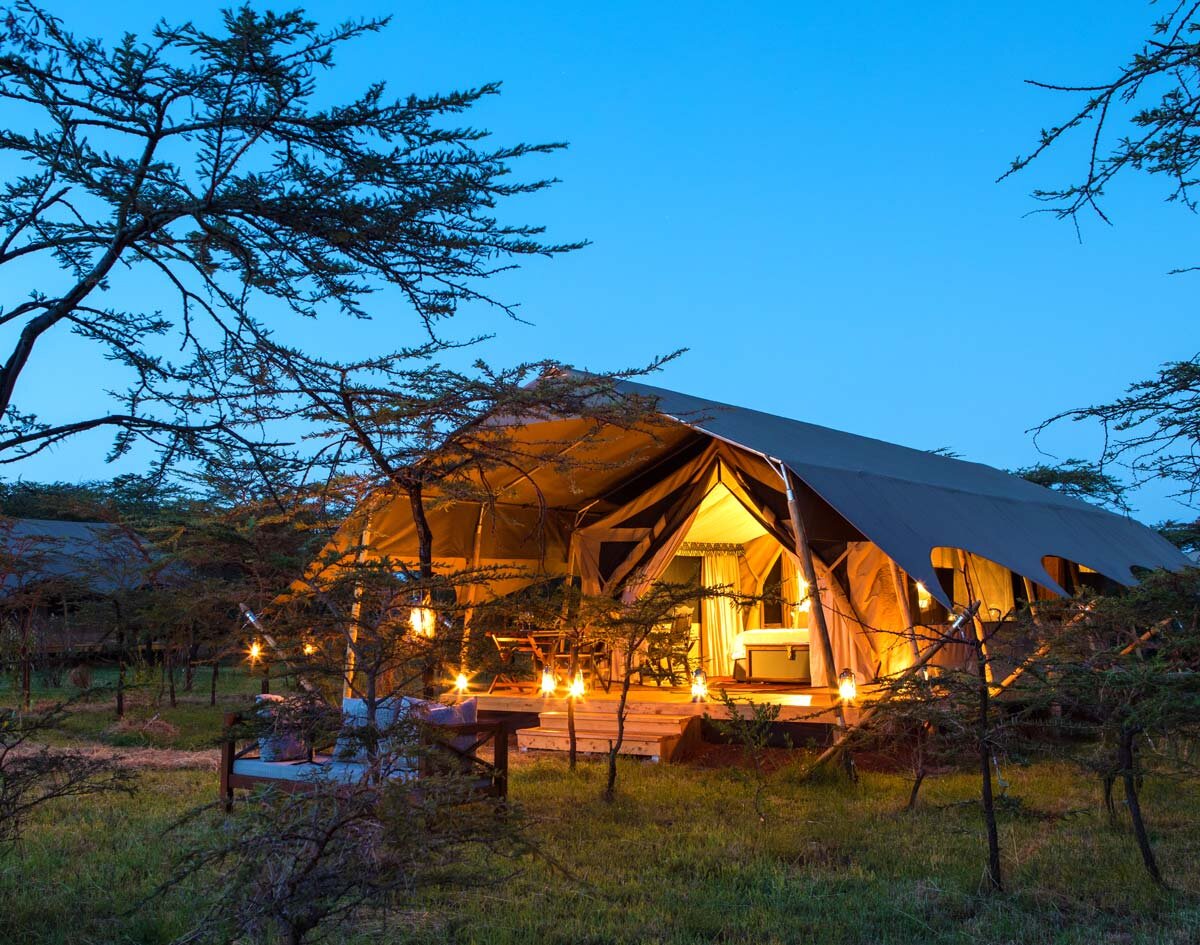
Mara Expedition Camp
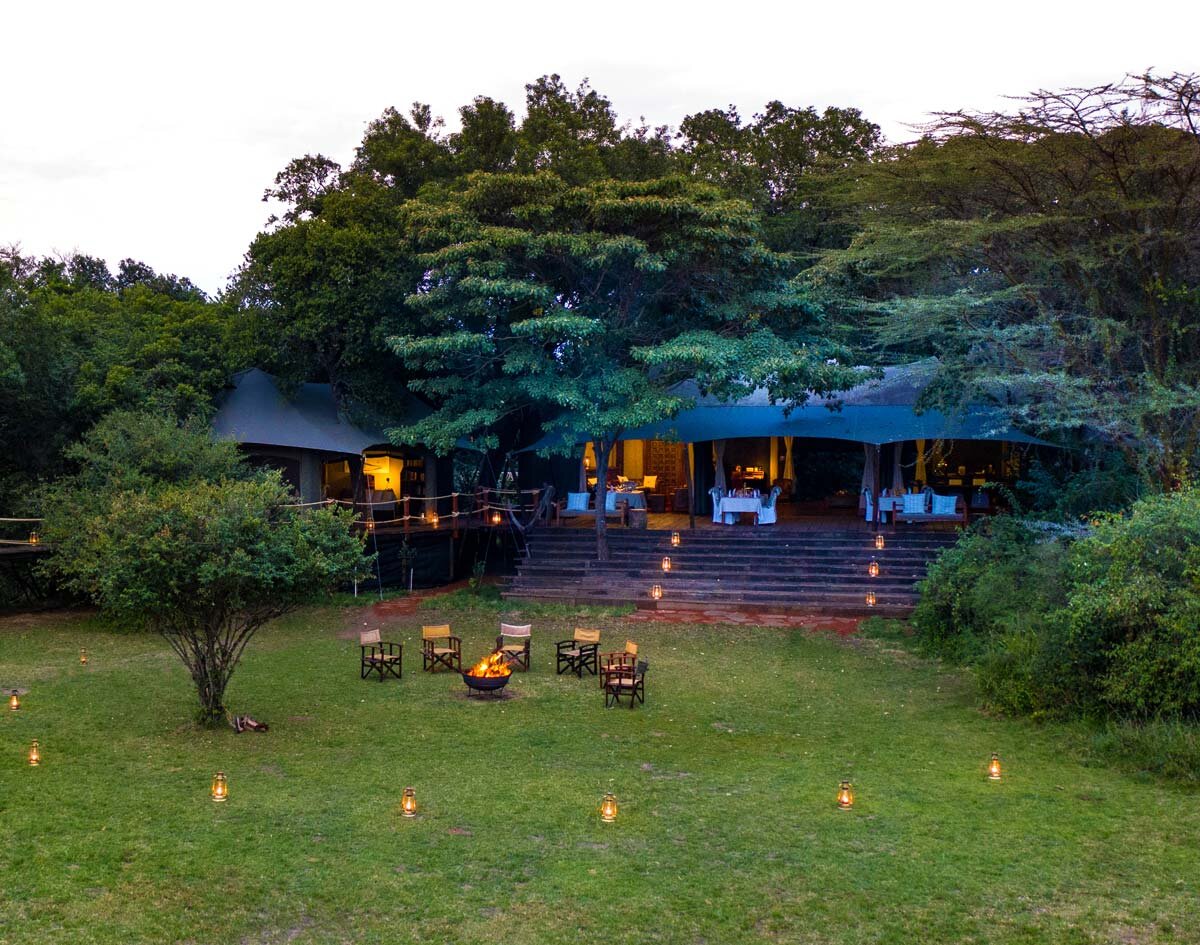
Mara Plains Camp

Mara Toto Tree Camp
Please feel free to contact Great Plains Conservation at:
Website Great Planes Conservation Lodges & Camps
General contacts: info@greatplainsconservation.com
Phone & WhatsApp: +27 (0)87 354 6591 or +27 (0)78 048 5543.
General contacts: info@greatplainsconservation.com
Phone & WhatsApp: +27 (0)87 354 6591 or +27 (0)78 048 5543.
Kenya Masai Mara
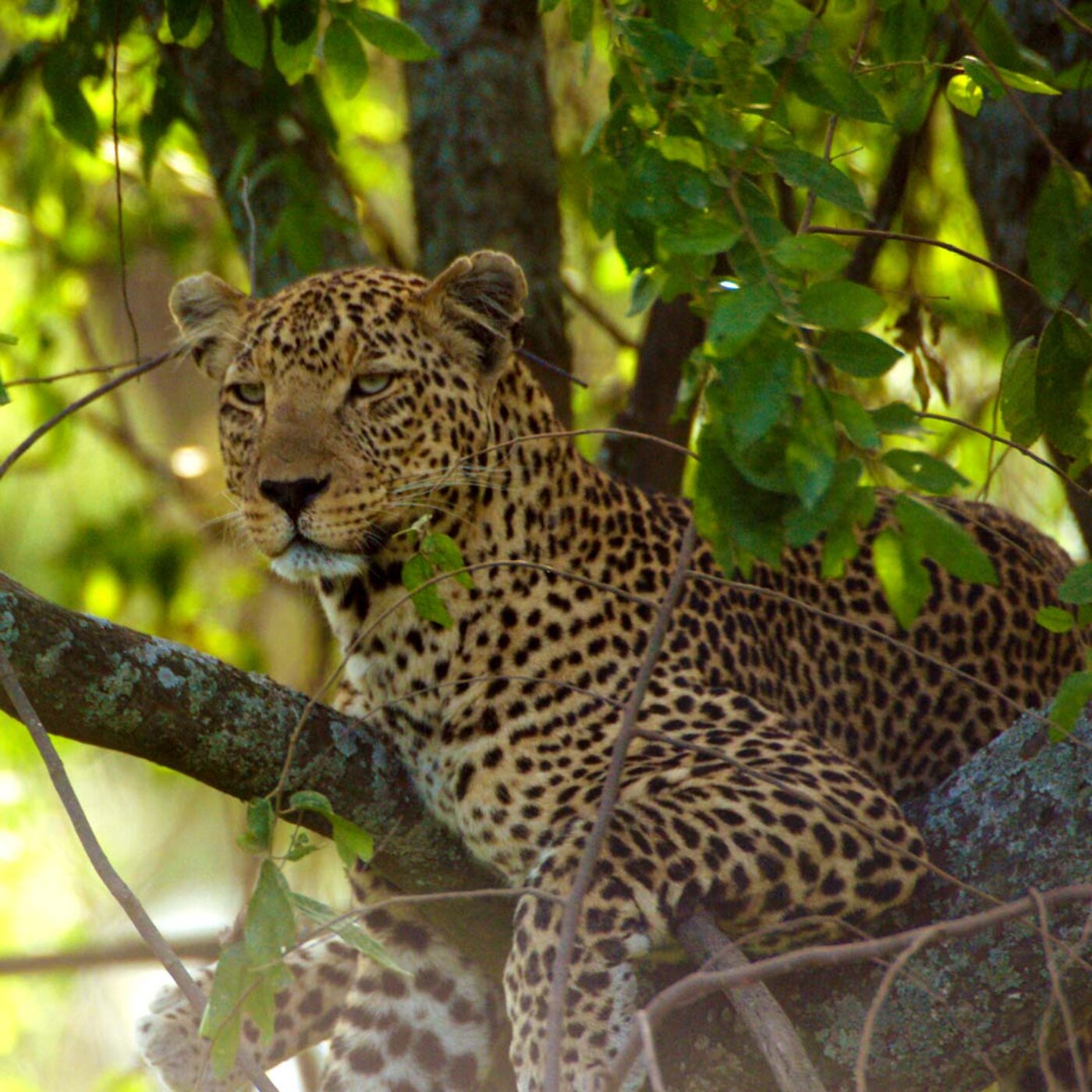
© Image: Henry Jedelsky
Flamingos on Lake Nakuru, a balloon safari over the Masai Mara, golden sandy beaches on the island of Lamu in the Indian Ocean – Kenya has a lot to offer. A traditional Kenyan safari usually starts in Nairobi, at the renowned Fairmont Norfolk Hotel. Theodore Roosevelt and Ernest Hemmingway have stayed there and their hunting photos still decorate the hallways of this historic, comfortable house. After a hearty English breakfast on the Lord Delamere terrace, we climb into our dark green Landcruisers and head west.
Nakuru National Park

Soon the striking escarpment of the Great Rift Valley unfolds ahead, and the road winds down into its depths. We soon reach the bottom of the Great Rift Valley and turn north, past Lake Naivasha and Lake Elementeita. Our destination today is Nakuru National Park with its alkaline lake, millions of flamingos, and the cozy Flamingo Hills Lodge. The evening excursion takes us to the shore of the lake. Resembling a cloud painted in white, pink, and red hues, a flock of flamingos stands at a distance on the lake. Shortly after, eight white rhinos gracefully cross the slope while grazing. Our jeep rushes through the terrain with a long trail of dust. In the forest, high in the thick foliage, the leopard cannot be overlooked against the setting sun.
Masai Mara Air Ballon Ride
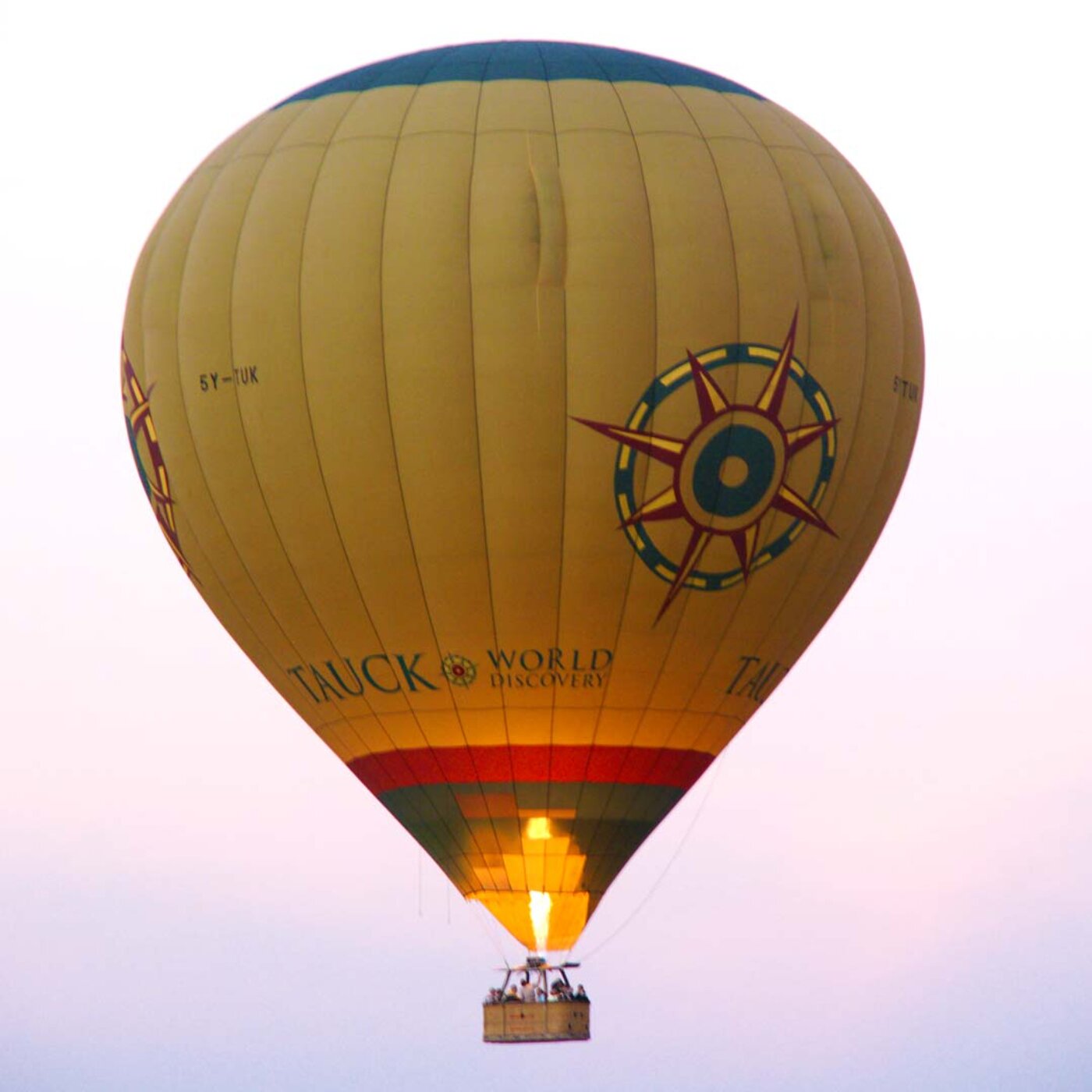
© Image: Henry Jedelsky
The Masai Mara is our next destination. Starting from the northwesternmost corner of the Masai Mara Reserve, we want to view the vast ecosystem from the air in a hot air balloon - one of the most beautiful and exclusive ways to experience the African wilderness. After a restful night in the exquisite tent of the Fairmont Mara Safari Club and a cozy early morning tea in the club's fireplace room, the balloon pilot explains to us that we will drive to the launch site by off-road vehicle in about an hour and a half. They move quickly through the dark African night, only to be interrupted by the brake lights of the vehicle in front.
The day slowly begins to awaken and we are at the starting point. A few short instructions and the balloon will rise. We glide quietly and almost noiselessly over the low umbrella acacias of the Masai steppe. The sun jumps over the cloudless horizon, casting golden brown and long black shadows across the grassy plain - the force of a dawning African day is overwhelming. The first herds of zebra and wildebeest glide beneath us. Some giraffes snack on the tops of the acacia trees. We climb a little higher and see the wide grassy plains of the Musiara Plains, which will turn black with wildebeest in a few days. The golden grass merges into the blue-green gallery forests on the Mara River, where famous tent camps such as Governors Camp, Ol Moran, and Kitchwa Tembo are located. Behind it rises the blue line of the Oloololo Mountains, which also form the western border of the animal reserve. We cross a valley covered in trees and bushes where family groups of steppe elephants roam. With the second balloon always in sight, we climb up out of the valley again, gliding over startled impalas and eland antelopes as well as scattered Thompson gazelles grazing. We descend quickly and the pilot tells us to get ready for landing.
We touch down almost unnoticed, a gentle jolt and the balloon envelope collapses quietly next to us. We get out of the basket, which now stands alone in the wide plain, and walk the last few hundred meters to the vehicles. Tables, chairs, and a buffet are already set up there for a champagne breakfast.
The day slowly begins to awaken and we are at the starting point. A few short instructions and the balloon will rise. We glide quietly and almost noiselessly over the low umbrella acacias of the Masai steppe. The sun jumps over the cloudless horizon, casting golden brown and long black shadows across the grassy plain - the force of a dawning African day is overwhelming. The first herds of zebra and wildebeest glide beneath us. Some giraffes snack on the tops of the acacia trees. We climb a little higher and see the wide grassy plains of the Musiara Plains, which will turn black with wildebeest in a few days. The golden grass merges into the blue-green gallery forests on the Mara River, where famous tent camps such as Governors Camp, Ol Moran, and Kitchwa Tembo are located. Behind it rises the blue line of the Oloololo Mountains, which also form the western border of the animal reserve. We cross a valley covered in trees and bushes where family groups of steppe elephants roam. With the second balloon always in sight, we climb up out of the valley again, gliding over startled impalas and eland antelopes as well as scattered Thompson gazelles grazing. We descend quickly and the pilot tells us to get ready for landing.
We touch down almost unnoticed, a gentle jolt and the balloon envelope collapses quietly next to us. We get out of the basket, which now stands alone in the wide plain, and walk the last few hundred meters to the vehicles. Tables, chairs, and a buffet are already set up there for a champagne breakfast.
Old Town Lamu
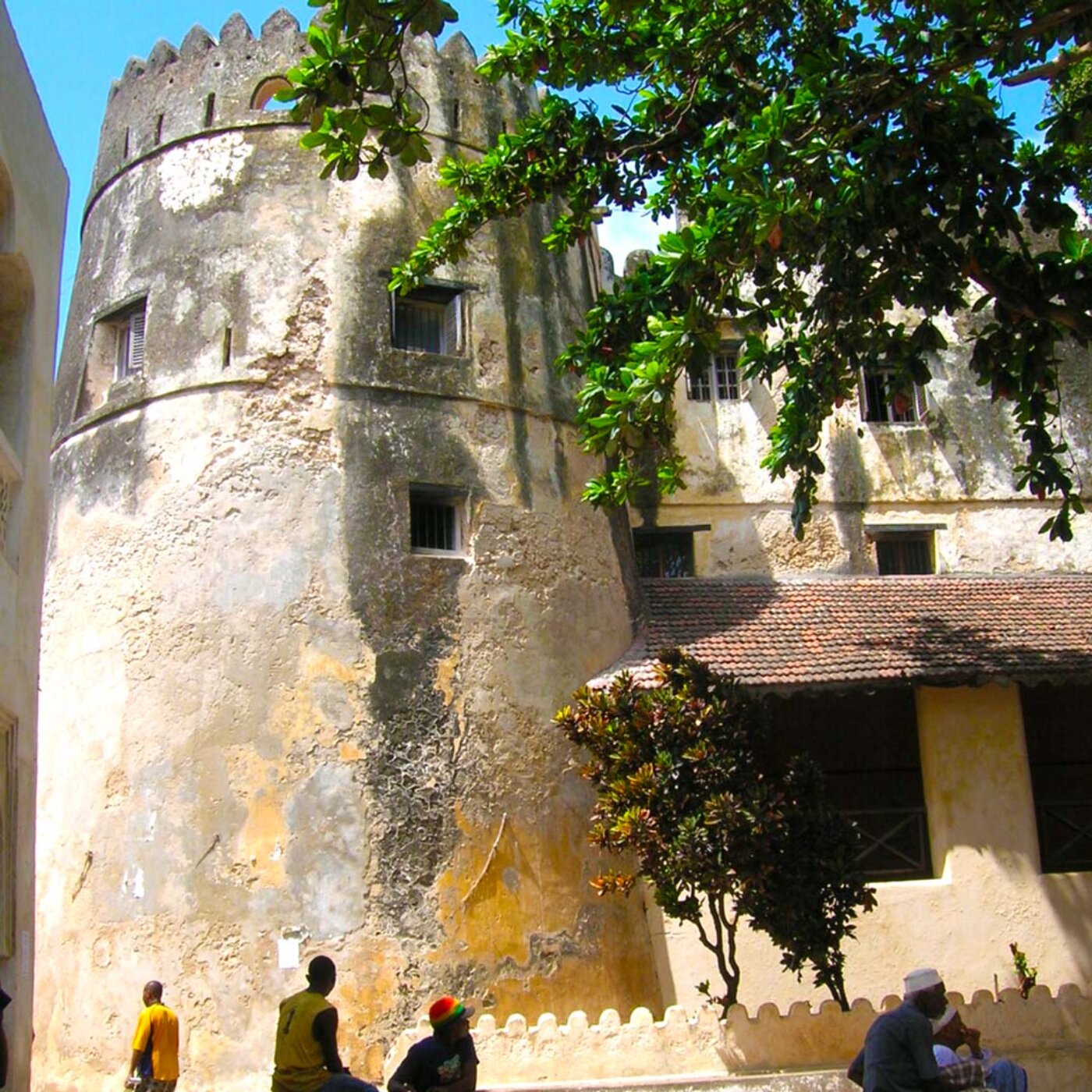
© Image: UNESCO/Patricia Alberth
A plane awaits us at the nearby airstrip, ready to transport us to the northeastern coast. Flying over the vast Tana River delta and Lamu Island, we later arrive by boat. Lamu stands as the last stronghold of Swahili culture, its old town seemingly untouched by the passing centuries. The alleys retain the essence of the era when the Sultan of Oman shifted his governmental base to Zanzibar, and Omani trade fleets traveled as far as Sumatra. Dhows, the Arab wooden ships that forty years ago sailed with the monsoon winds to India and back, are moored at the harbor quay. Some wonderfully carved entrance doors and dark, mysterious shops also bear witness to times gone by. We board a longboat and glide out of the lively harbor. Soon the mangrove forest recedes and the shore widens into a kilometer-long, golden-yellow sandy beach, behind which dark green coconut palms sway in the evening sun.
Kizingoni Beach
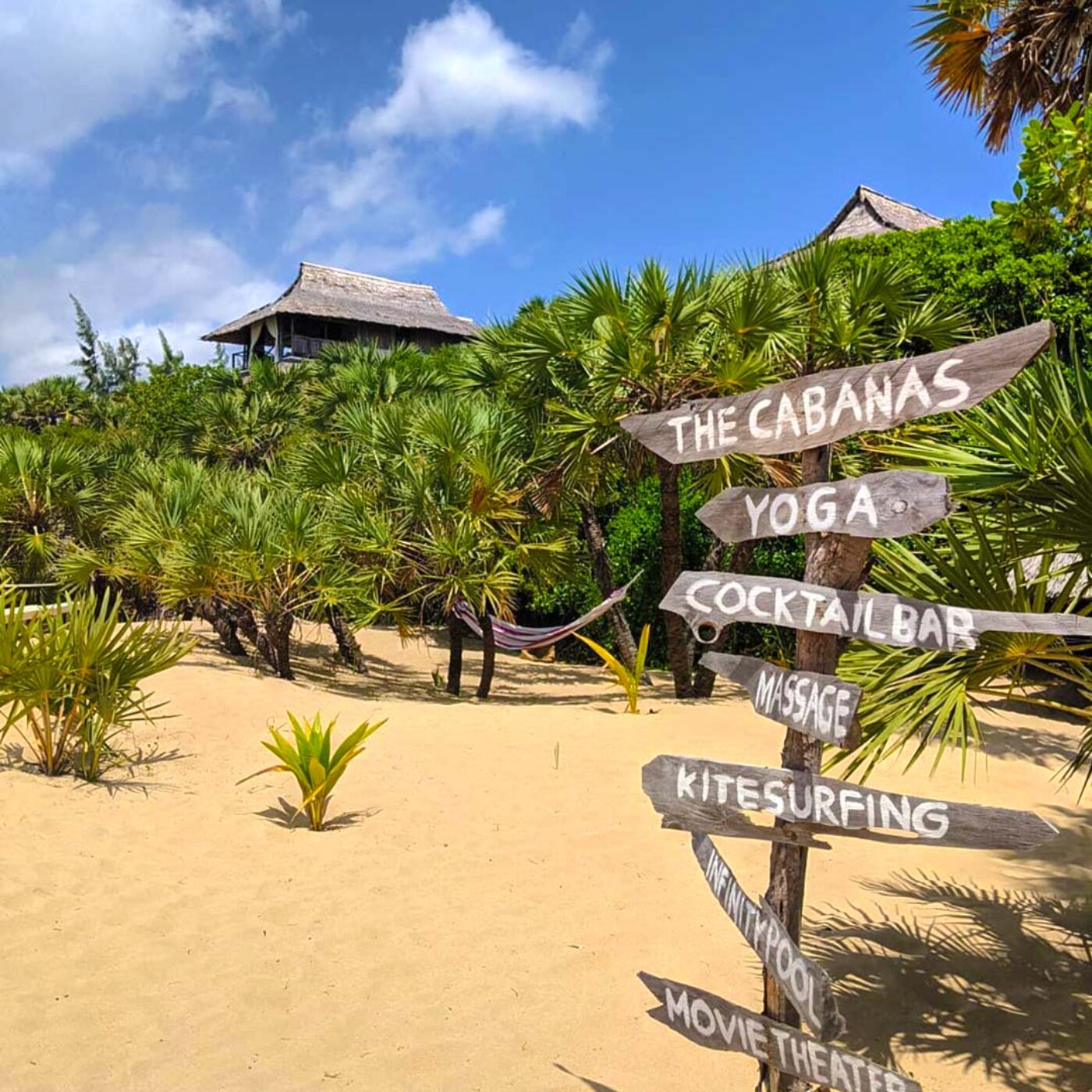
© Image: The Cabanas Lamu
The Cabanas Lamu feature seven expansive beach villas, designed in the spacious Lamu style. These villas boast wide halls, breezy rooms with seating areas, and rooftop terraces featuring hanging beds where the warm breeze gently blows. The color palette includes white, clay brown, ocher, and muted yellow, maintaining a serene and harmonious atmosphere without any vibrant tones disrupting the tranquility. There is no air conditioning, which is not necessary with this traditional construction, and all electricity is generated from solar panels on site. On the spacious beach with crystal-clear waters, you'll find solitude. When you're ready to move beyond relaxation, various options await trips to Lamu, camel riding on Shela, flying safaris to the nearby Tana Delta, kayaks, water skiing, snorkeling, swimming with wild dolphins, and trips with the hotel's own Dhow, for example, popular sunset cruise with the even more popular sundowner. The sea around Lamu is also one of the ten best places in the world for deep-sea fishing. If desired, a beach dinner on the beach with torch lighting can be arranged in the evening. And if you then lean back from the circle of light and look up, you will see the huge, velvety black African sky with the brightly glittering Milky Way and the sparkling stars of the south. Comfort, peace, and solitude - the true luxury of Africa is revealed in Kizingoni Beach.
Important Kenya Information
Please always check your with your travel agent or go directly to the website of the Kenyan Embassy in your home country for up-to-date travel information.
Visa:
Tourists need a Visa to enter Kenya. Tourist visas can be obtained online at the Onlne Portal for E-Visas
Health:
Get comprehensive travel insurance covering global medical expenses. Check exclusions to ensure your activities are covered. Check what vaccinations you may need for your trip at least eight weeks before you travel – you can get information about vaccinations from your travel agent or an International Health and Travel Centre.
Malaria is a year-round risk across Kenya. Protect yourself by wearing long clothing, using insect repellent on the skin, and sleeping under mosquito nets, especially after sunset.
Water:
Visitors are advised to drink bottled water.
For emergency services in Kenya, dial 999, 112, or 911.
Climate:
Kenya lies on the equator and enjoys a tropical climate with significant regional differences due to factors like altitude. Daytime temperatures generally range from 20°C/68°F to 28°C/82°F, with the coast experiencing warmer conditions.
Visa:
Tourists need a Visa to enter Kenya. Tourist visas can be obtained online at the Onlne Portal for E-Visas
Health:
Get comprehensive travel insurance covering global medical expenses. Check exclusions to ensure your activities are covered. Check what vaccinations you may need for your trip at least eight weeks before you travel – you can get information about vaccinations from your travel agent or an International Health and Travel Centre.
Malaria is a year-round risk across Kenya. Protect yourself by wearing long clothing, using insect repellent on the skin, and sleeping under mosquito nets, especially after sunset.
Water:
Visitors are advised to drink bottled water.
For emergency services in Kenya, dial 999, 112, or 911.
Climate:
Kenya lies on the equator and enjoys a tropical climate with significant regional differences due to factors like altitude. Daytime temperatures generally range from 20°C/68°F to 28°C/82°F, with the coast experiencing warmer conditions.
Kenya Great Plains

© Image: Henry Jedelsky
It does not get any better than this! Great Plains Conservation is setting new standards with its camps and lodges in Botswana, Zimbabwe, and Kenya. Our Africa specialists, Elisabeth and Henry Jedelsky, were invited to Kenya and met two African celebrities.
The Ol Donyo Lodge is located at the foot of the Chyulu Mountains near Tsavo West and Amboseli National Park. Ernest Hemingway wrote about the enchanting landscape in his book "The Green Hills of Africa". At the end of December, after the "Short Rain Period", the mountains shimmer in the morning light, and the vast plain gleams in fresh green, interspersed with small white flowers. A small twin-engine aircraft from Safari Link, piloted by a female pilot, brought us here from Nairobi in just under an hour, where an open Toyota Land Cruiser was already waiting. On the way to the lodge, we encounter three cheetah brothers who have killed a Thompson's gazelle. The savannah is dotted with giraffes, two bulls are fighting among the acacia trees, watched by a group of riders. The lodge offers not only bush walks and game drives but also its own stable for horseback riding and excursions. At Ol Donyo, a lunch with selected delicacies awaits us. We learn that at Great Plains Lodges, all drinks, including all alcoholic ones, are always included. In each camp, you can taste wines from around the world, mostly from South Africa, in the on-site wine cellar. Each of the five housing units consists of a spacious room with adjoining rooms. From the bed, if you push aside the mosquito net, you can see Mount Kilimanjaro through the panoramic window.
The Ol Donyo Lodge is located at the foot of the Chyulu Mountains near Tsavo West and Amboseli National Park. Ernest Hemingway wrote about the enchanting landscape in his book "The Green Hills of Africa". At the end of December, after the "Short Rain Period", the mountains shimmer in the morning light, and the vast plain gleams in fresh green, interspersed with small white flowers. A small twin-engine aircraft from Safari Link, piloted by a female pilot, brought us here from Nairobi in just under an hour, where an open Toyota Land Cruiser was already waiting. On the way to the lodge, we encounter three cheetah brothers who have killed a Thompson's gazelle. The savannah is dotted with giraffes, two bulls are fighting among the acacia trees, watched by a group of riders. The lodge offers not only bush walks and game drives but also its own stable for horseback riding and excursions. At Ol Donyo, a lunch with selected delicacies awaits us. We learn that at Great Plains Lodges, all drinks, including all alcoholic ones, are always included. In each camp, you can taste wines from around the world, mostly from South Africa, in the on-site wine cellar. Each of the five housing units consists of a spacious room with adjoining rooms. From the bed, if you push aside the mosquito net, you can see Mount Kilimanjaro through the panoramic window.
Derek Joubert, Chairman of Great Plains Conservancy and a famous wildlife filmmaker, has furnished each room of the lodges and the spacious tents of all his camps stylishly and individually with reading chairs, desks, safari trunks, and huge animal photographs by his wife, Beverly. Two binoculars, often from Swarovski, and a Canon EOS 5D with two powerful zoom lenses are included, as well as chargers for all plugs, insect repellent, and reading glasses. Additionally, the latest photo books by Beverly Joubert are provided. The bathroom features a freestanding bathtub, indoor and outdoor showers, and a terrace with loungers, leading to a private, crescent-shaped swimming pool that allows more than just two laps. From the daybed on the rooftop terrace, you can admire the incredible starry sky at night. The morning game drive takes us to two large "Tuskern" elephants, huge bull elephants currently crossing over from the nearby Amboseli National Park. Back at the lodge, we enjoy a four-course meal in the library next to the pool, where colorful agama lizards frolic, enjoying the view of the vast plain and the waterhole just like us. Unfortunately, the red light of the spotlight disables our cameras during the night game drive. So, we focus on cheetahs, spring hares, and the constellations of Orion, Capella, and the fantastic Milky Way. The early morning game drive leads through the open woodland to an acacia tree where a bush breakfast awaits us: A set table with a carpet and two chefs provide everything needed. The Maasai waitress, Koro, opens a bottle of Taittinger Champagne, which we empty while gazing at Mount Kilimanjaro. What an incredible luxury in Africa!
The next day, we continue our journey: Once again, a female pilot takes us, with the snow-capped peak of Mount Kilimanjaro to our left and the water bodies of the Amboseli reserve below us, back to Nairobi and onwards over the impressive rift valley to the highlands of the world-famous Masai Mara, the "spotted land." The renowned Masai Mara National Reserve was established as early as 1948 and has been expanded several times since then. From 2005 onwards, the new "Conservancies" were established north of this protected area. The land still belongs to individual Masai tribes and is leased by private camps and lodges. These areas refrain from extensive cattle farming and agriculture. Instead, antelopes graze, lions and cheetahs roam, and elephants and even some rhinos wander the vast plains. Between June and October, the entire region is the stage for the famous "migration," the movement of hundreds of thousands of gnus and zebras migrating from the Serengeti, providing spectacular images of their river crossings, known as the "Crossings." In May 2006, the Olare Motorogi Conservancy was established, covering approximately 14,000 hectares, equivalent to about ten percent of the "original" Masai Mara National Reserve. In addition, there are five other Conservancy protected areas, all with private camps and lodges. Boundaries exist only on paper; the gnus, zebras, lions, and cheetahs wander freely, and if the daily fee is paid, safari vehicles are allowed to follow the wildlife in both directions. We land at the Ol Kiombo Airstrip on the Central Plains, where our drive guide Nancy awaits us with her Land Cruiser. She is an unmarried Masai from a nearby village and has been a fully trained guide for seven years after studying in Nairobi. I recall: In August, we encountered a woman as a guide in Zambia. Africa's women not only conquer the skies as pilots but also the wilderness as guides and camp managers.
The great gnu migration has already passed through here, countless topis with their newborn calves, majestic elands, impalas, Grant's gazelles, kongonis, and even the elegant giraffe gazelles populate the savannah and delight in the fresh greenery. Cheetahs play with their young, and spotted hyenas enjoy mud baths. We head north into the Olare Motorogi Conservancy and are already expected at the Mara Expedition Camp, which boasts only six tents but 36 staff members. We enjoy two wonderful days with the luxury that Great Plains Conservancy offers here. In the evening, we experience a show-cooking event by the Masai chefs of the camp, accompanied by their old, often melancholy songs. There's even a pool mounted on an old GMC truck. And as always, Wi-Fi intentionally works only in the individual tents, guests are meant to enjoy and engage in conversation. Unfortunately, we have to cancel a visit to the Marsh Pride lion pride, famous for countless television documentaries, because of a flooded river. Instead, Nancy takes us to a lion couple.
The great gnu migration has already passed through here, countless topis with their newborn calves, majestic elands, impalas, Grant's gazelles, kongonis, and even the elegant giraffe gazelles populate the savannah and delight in the fresh greenery. Cheetahs play with their young, and spotted hyenas enjoy mud baths. We head north into the Olare Motorogi Conservancy and are already expected at the Mara Expedition Camp, which boasts only six tents but 36 staff members. We enjoy two wonderful days with the luxury that Great Plains Conservancy offers here. In the evening, we experience a show-cooking event by the Masai chefs of the camp, accompanied by their old, often melancholy songs. There's even a pool mounted on an old GMC truck. And as always, Wi-Fi intentionally works only in the individual tents, guests are meant to enjoy and engage in conversation. Unfortunately, we have to cancel a visit to the Marsh Pride lion pride, famous for countless television documentaries, because of a flooded river. Instead, Nancy takes us to a lion couple.
Our final destination, the Mara Plains Camp, is situated directly on the Ntiakitiak River, also within the Olare Motorogi Conservancy. It was the first camp established by Great Plains Conservancy in Kenya and is probably the most spacious. It also offers only six tents. We estimate ours to be nearly seventy square meters. Unfortunately, we don't have time to try out the copper bathtub. Instead, we meet Beverly and Derek Joubert, who are also currently staying and working here. In the evening, Derek shares his story with me over a gin and tonic by the campfire: his camps in Botswana, Zimbabwe, and his plans in Kenya and Tanzania. Meanwhile, Beverly chats freely with other guests of the camp. The next day, we have the opportunity to accompany them to observe a cheetah with four cubs. It's a beautiful experience watching them work with a film camera and a giant telephoto lens. Time flies by, with hunting lions, a female leopard in a tree, and a nocturnal hippo calling right next to the tent. During the game drives, we are provided with additional practical comforts: thermos flasks on the seats during the early morning drive, rain ponchos for bad weather, protective glasses for insect swarms, and aluminum water bottles we can take home.
Soon it's time to head back to Nairobi, where the 60th Independence Day is being celebrated and our Ethiopian Airlines plane awaits. However, the departure is delayed because we are taking on board a prominent guest - the Ethiopian president, who appreciates the amenities of the business class.
Author: Henry Jedelsky
Soon it's time to head back to Nairobi, where the 60th Independence Day is being celebrated and our Ethiopian Airlines plane awaits. However, the departure is delayed because we are taking on board a prominent guest - the Ethiopian president, who appreciates the amenities of the business class.
Author: Henry Jedelsky
Namibia
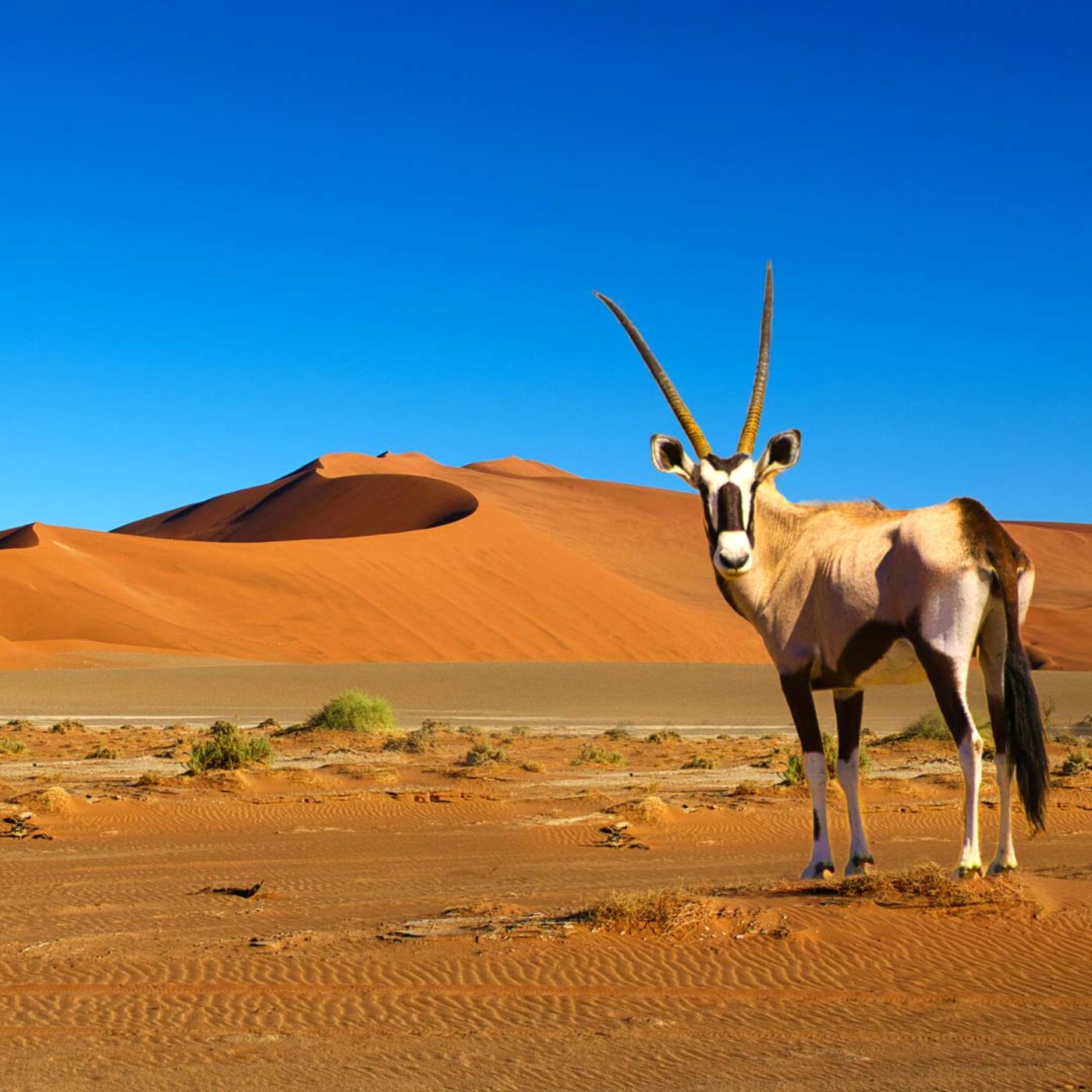
After arriving at Windhoek Airport, begin your day with a delightful breakfast experience at Hotel Heinitzburg, a beautifully restored castle hotel perched atop a hill in Windhoek. We then head towards Swakopmund. Green thorn bushes line the street, accompanied by kites and ibises in the sky. The desert-like Dorob National Park opens up about 40 km from the city. Before that, however, we enjoyed a breathtaking sunset at the Tug Beach restaurant on the old jetty, accompanied by fresh oysters, excellent oryx carpaccio, and delicious rock lobster.
Exploring the Desert
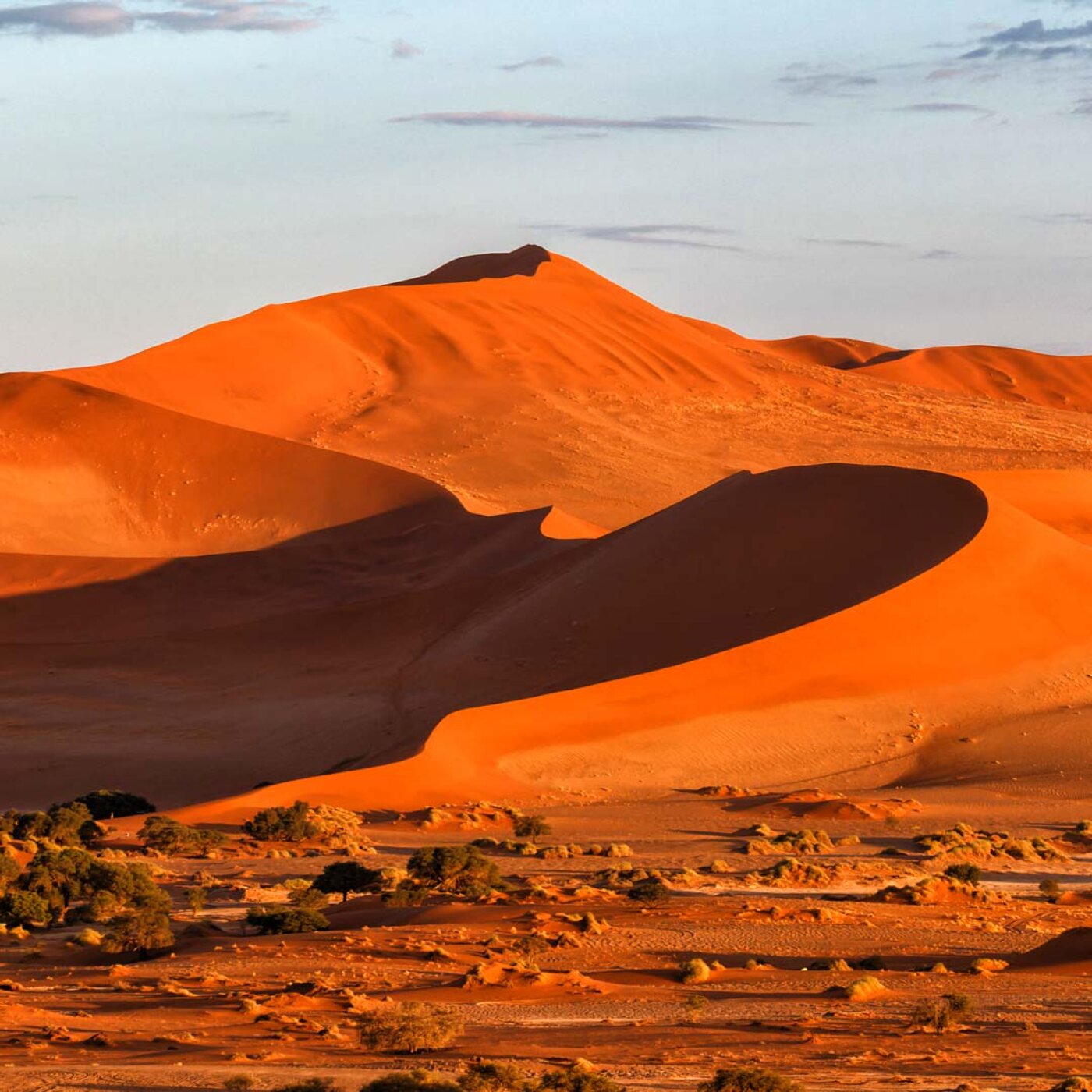
The next morning we explore the hidden life of the desert deep in the sand dunes on a desert tour. We meet a fast Namib chameleon, an almost transparent Palmato gecko, a gray and white striped horned viper, and a sidewinder, a sand viper that swims in the sand. We also spot the famous black ground beetles and shy gray wheatears.
The next day the journey takes us south through the Namib-Naukluft National Park and thus through the oldest desert in the world. Several oryx antelopes, resilient creatures who can survive without relying on open water sources, observe our passage toward the Namib Dune Star Camp. This unique camp is nestled atop fossilized dunes that bear the weight of millions of years of history. The next day we go to Sossusvlei, the red heart of the Namib. The morning sun makes the huge dunes glow red, but soon the color changes to dark ocher, and deep black shadows follow the sweeping dune ridges. In the middle of this gigantic panorama lies the Dead Vlei, a clay pan from which the skeletons of dead acacia trees protrude. They died nearly five hundred years ago when the Tsauchab Dry River changed course and are now popular photo subjects.
The next day the journey takes us south through the Namib-Naukluft National Park and thus through the oldest desert in the world. Several oryx antelopes, resilient creatures who can survive without relying on open water sources, observe our passage toward the Namib Dune Star Camp. This unique camp is nestled atop fossilized dunes that bear the weight of millions of years of history. The next day we go to Sossusvlei, the red heart of the Namib. The morning sun makes the huge dunes glow red, but soon the color changes to dark ocher, and deep black shadows follow the sweeping dune ridges. In the middle of this gigantic panorama lies the Dead Vlei, a clay pan from which the skeletons of dead acacia trees protrude. They died nearly five hundred years ago when the Tsauchab Dry River changed course and are now popular photo subjects.
Lüderitz & Kolmanskop
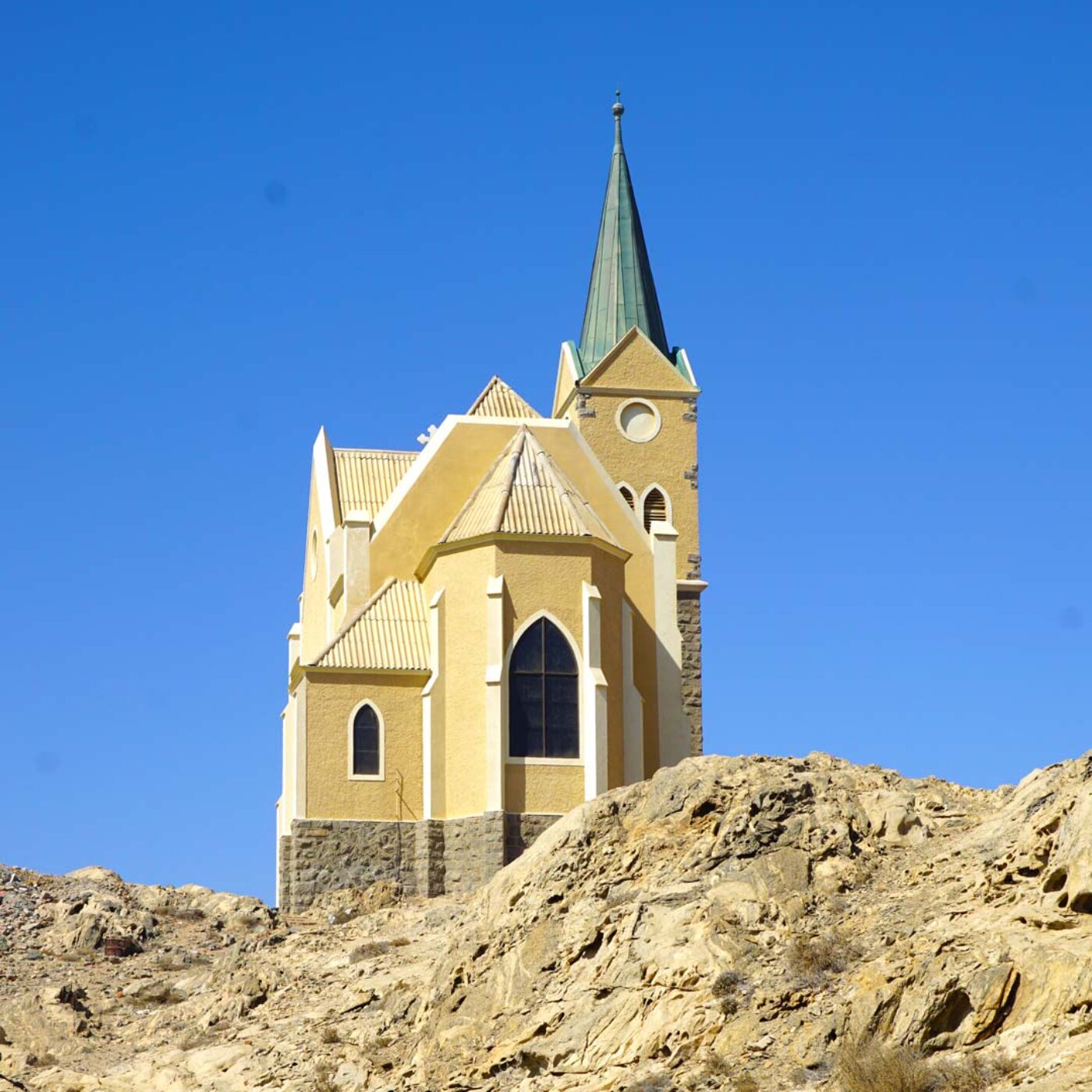
© Image: Henry Jedelsky
The journey continues south, past bizarrely jagged Dolomite mountains and along the former diamond-restricted area to Lüderitz, the town with the characteristic rock church that is still unmistakably characterized by old German colonial architecture. At the Lüderitz Nest Hotel, located on a headland, we enjoy the à la carte menu with delicious oysters and fresh rock lobsters. Staying overnight in Lüderitz? Visit Kolmanskop! The former city of diamond prospectors is reclaimed by the desert, now a fascinating open-air museum. Abandoned steel beds sink into sand dunes where nurses once scurried, leaving only traces of hyenas.
Fish River Canyon
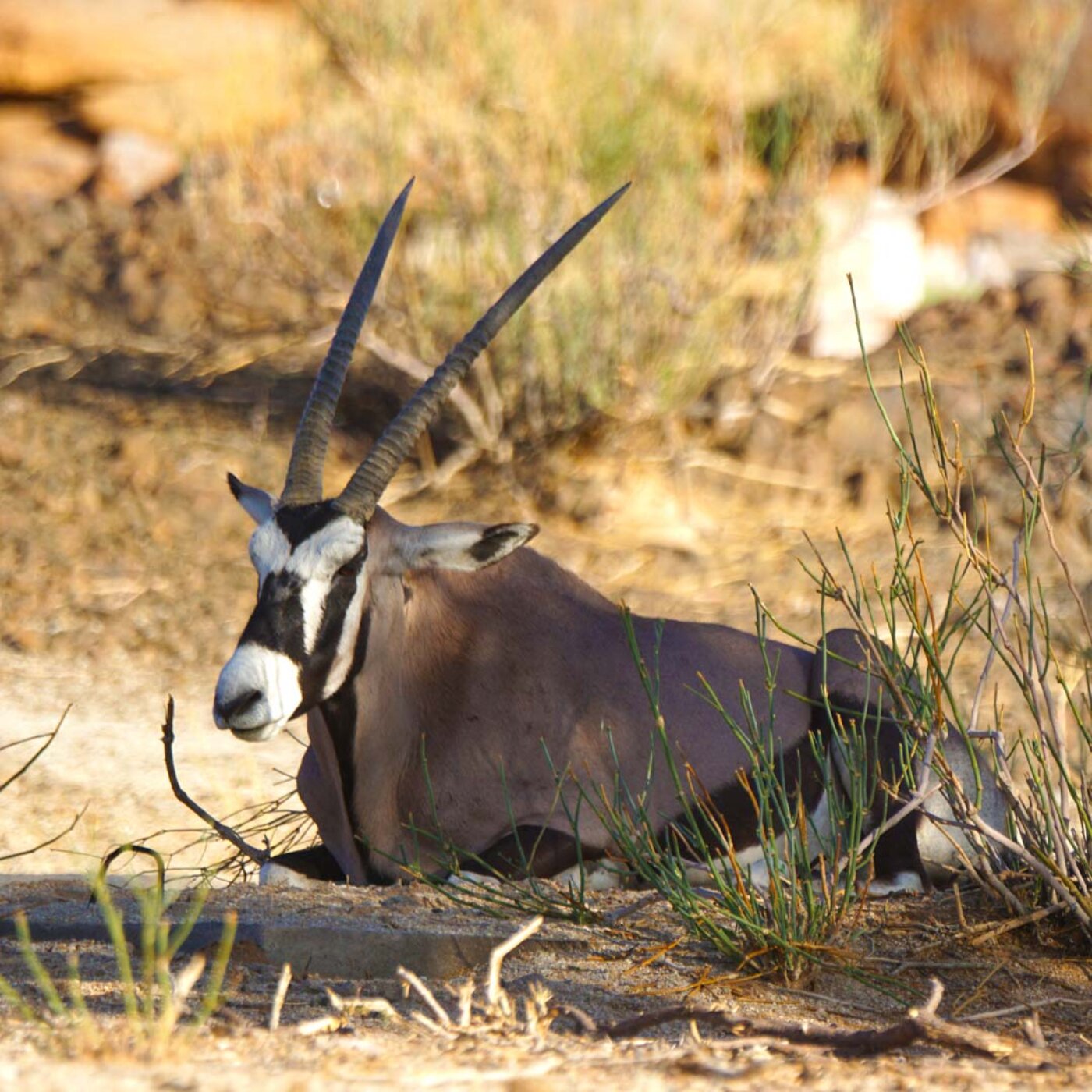
© Image: Henry Jedelsky
The next day we visit the Fish River Canyon, the second largest canyon in the world, and stay at the Canyon Lodge. The bungalows and pool are perfectly integrated amidst high boulders, and the former farmhouse has been converted into a restaurant with a large terrace. Between the rocky peaks and the old trees lie grassy areas where oryx antelopes graze and a pack of rock hyraxes scurry around. Africa has rarely offered me a lodge in such inspiring surroundings - the traditional sundowner and the evening barbecue under the fascinating, glittering starry sky reinforce this first impression.
The southern part of Namibia strives to offer guests the highest level of comfort in modern camps and lodges. Unique experiences and unforgettable moments await safari enthusiasts in the game reserves and national parks.
The southern part of Namibia strives to offer guests the highest level of comfort in modern camps and lodges. Unique experiences and unforgettable moments await safari enthusiasts in the game reserves and national parks.
Important Namibia Information
Please always check your with your travel agent or go directly to the website of the Namibian Embassy in your home country for up-to-date travel information.
Visa: Tourists do not need to apply for a Visa before traveling. Tourist visas will be issued upon arrival for stays up to 90 days.
Health:
Get comprehensive travel insurance covering global medical expenses. Check exclusions to ensure your activities are covered.Check what vaccinations you may need for your trip at least eight weeks before you travel – you can get information about vaccinations from your travel agent or an International Health and Travel Centre.
Malaria is a risk in some parts of Namibia. Protect yourself by wearing long clothing, using insect repellent on the skin, and sleeping under mosquito nets, especially after sunset.
Water
Drink or use only bottled water.
Emergency Police call +263 4 995
Climate:
Namibia has a subtropical climate with a dry winter and hot summer and the southern area faces a hot arid and steppe climate. The peak time for visiting Zimbabwe is from July to October, offering the best wildlife viewing experience.
Visa: Tourists do not need to apply for a Visa before traveling. Tourist visas will be issued upon arrival for stays up to 90 days.
Health:
Get comprehensive travel insurance covering global medical expenses. Check exclusions to ensure your activities are covered.Check what vaccinations you may need for your trip at least eight weeks before you travel – you can get information about vaccinations from your travel agent or an International Health and Travel Centre.
Malaria is a risk in some parts of Namibia. Protect yourself by wearing long clothing, using insect repellent on the skin, and sleeping under mosquito nets, especially after sunset.
Water
Drink or use only bottled water.
Emergency Police call +263 4 995
Climate:
Namibia has a subtropical climate with a dry winter and hot summer and the southern area faces a hot arid and steppe climate. The peak time for visiting Zimbabwe is from July to October, offering the best wildlife viewing experience.
Uganda
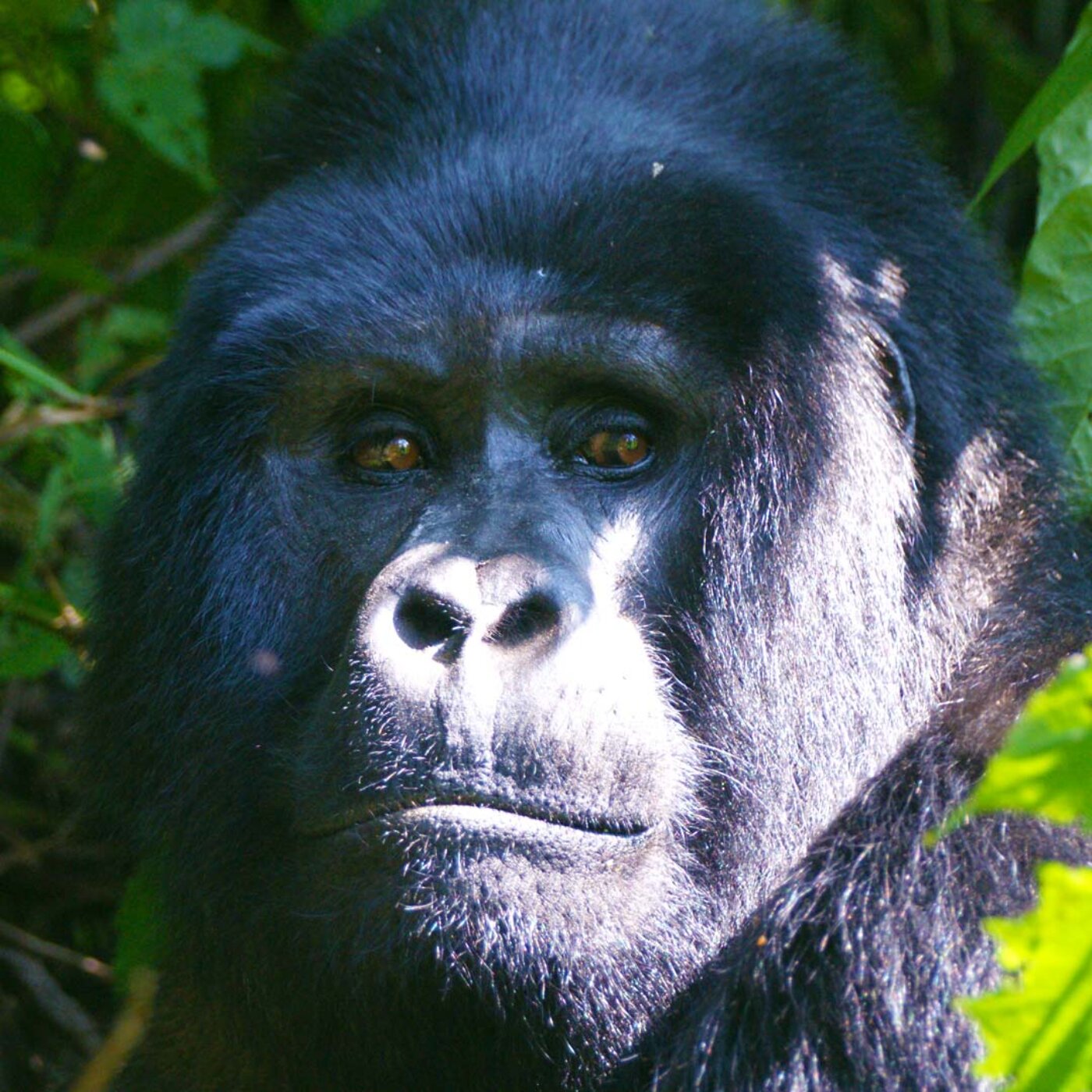
© Image: Henry Jedelsky
The deep blue African sky arches over the historic Entebbe airport. The seemingly endless expanse of Lake Victoria shines in the distance. After a short lunch at the Boma Hotel, we pay a visit to the Botanical Garden. This is where Johnny Weismüller once expertly swung from vine to vine as the iconic original Tarzan.
The next day our adventure begins with a one-hour boat trip on Lake Victoria. After crossing the equator we reach Ngamba Island. The island is a sanctuary for chimpanzees at the initiative of Jane Goodall. Over 50 chimpanzees live here practically in freedom and like to pose for our photos. We soon leave Entebbe behind us and, after a beautiful journey along the huge lake, reach Uganda's capital Kampala. We spend the night high above the city of millions in the Cassia Lodge, where we are treated to a beautiful panoramic view over Lake Victoria. The next morning we go to the Ziwa Rhino Sanctuary. The endangered white rhinos live here. They are guarded by game wardens as closely as the US gold reserves at Fort Knox. After a short hike, we come within photo-shooting distance of a group of seven pachyderms grazing peacefully.
The next day our adventure begins with a one-hour boat trip on Lake Victoria. After crossing the equator we reach Ngamba Island. The island is a sanctuary for chimpanzees at the initiative of Jane Goodall. Over 50 chimpanzees live here practically in freedom and like to pose for our photos. We soon leave Entebbe behind us and, after a beautiful journey along the huge lake, reach Uganda's capital Kampala. We spend the night high above the city of millions in the Cassia Lodge, where we are treated to a beautiful panoramic view over Lake Victoria. The next morning we go to the Ziwa Rhino Sanctuary. The endangered white rhinos live here. They are guarded by game wardens as closely as the US gold reserves at Fort Knox. After a short hike, we come within photo-shooting distance of a group of seven pachyderms grazing peacefully.
Murchison Falls National Park
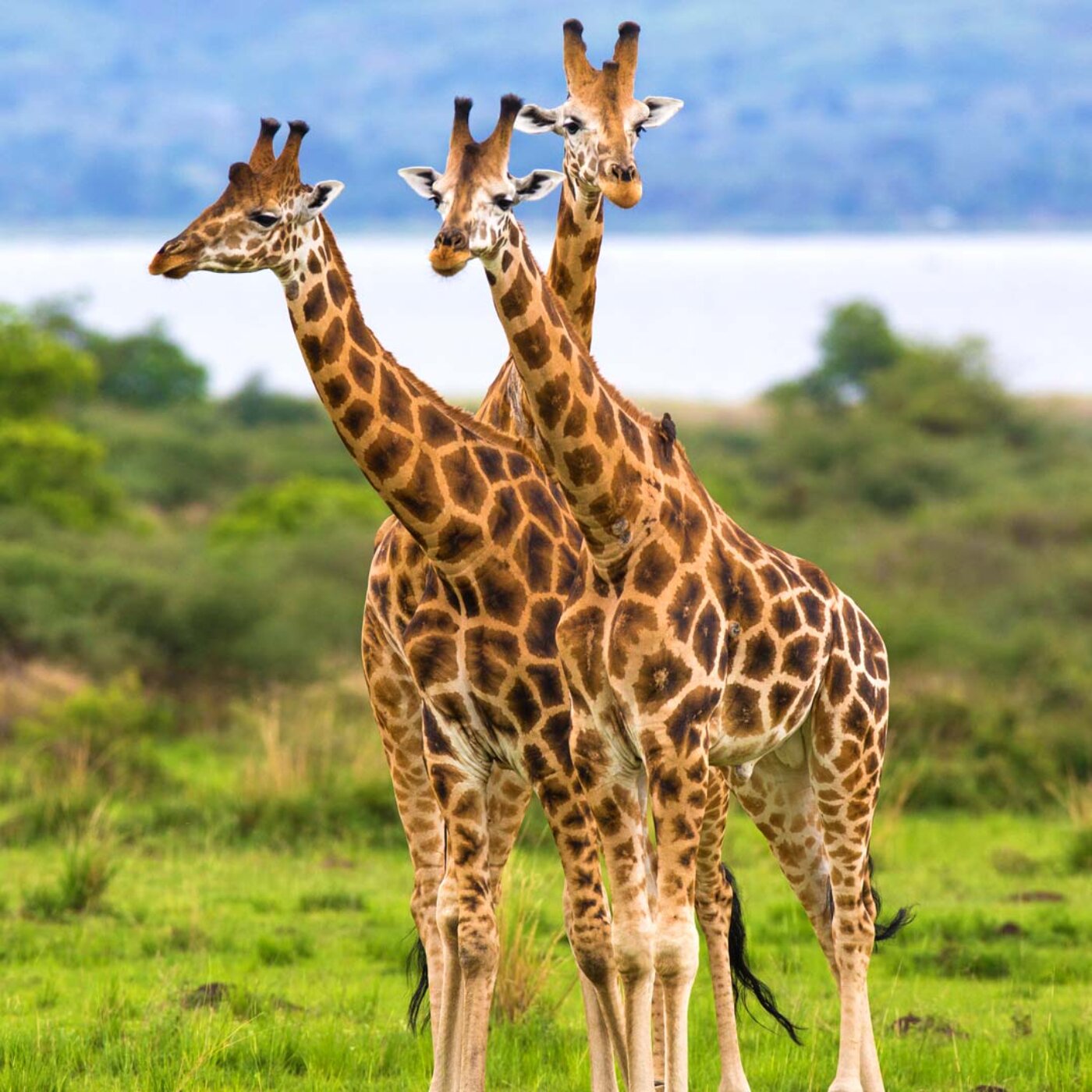
The journey then continues to Murchison Falls National Park. With a deafening roar, the Victoria Nile forces its way through a narrow crevice in the rock and creates a dense spray of millions and millions of water drops in which the sun's rays are refracted in all the colors of the rainbow. Baker's Lodge awaits us directly on the river bank. We spent the night in one of the spacious, comfortable bungalows. Strengthened by a hearty breakfast, we set off on a boat trip on the Viktoria Nile almost to Murchison Falls. The journey time through the savannah landscape is shortened by the sight of numerous giraffes, elephants, huge crocodiles, and almost countless birds. Hippos frolic in large groups in shallow water.
After another night at Baker's Lodge, the path takes us along Lake Albert through tea plantations and between herds of long-horned Ankole cattle to Hoima, where we check in at Ndali Lodge. The lodge has been enthroned here since 1922, right on the edge of a long-extinct volcanic crater with a unique view of the mist-shrouded peaks of the legendary Rwenzori Mountains, better known as the Moon Mountains.
After another night at Baker's Lodge, the path takes us along Lake Albert through tea plantations and between herds of long-horned Ankole cattle to Hoima, where we check in at Ndali Lodge. The lodge has been enthroned here since 1922, right on the edge of a long-extinct volcanic crater with a unique view of the mist-shrouded peaks of the legendary Rwenzori Mountains, better known as the Moon Mountains.
Queen Elizabeth National Park & Biwindi
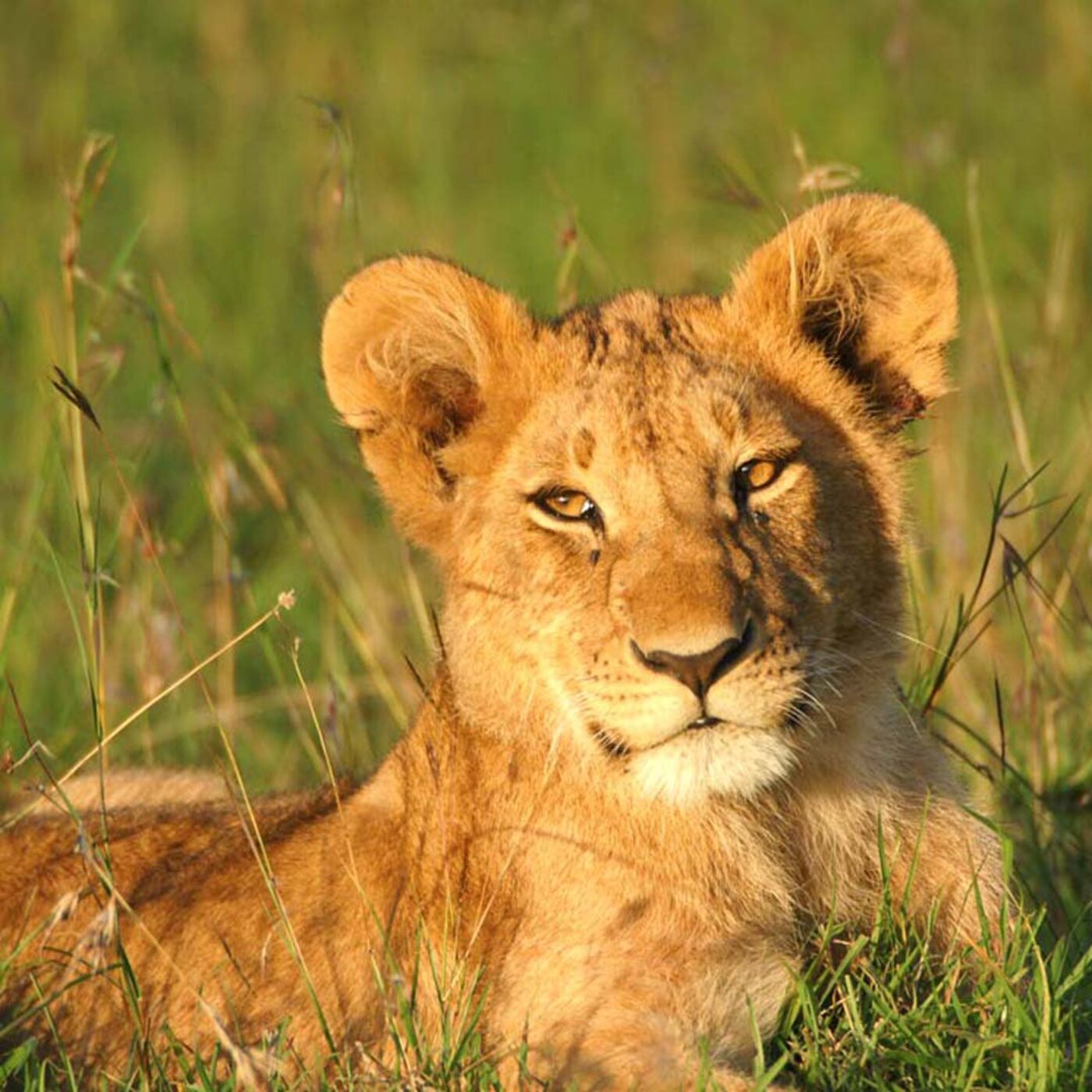
© Image: Henry Jedelsky
Further west we reach the famous Queen Elizabeth National Park. A trip in an off-road vehicle takes us to some of the eleven volcanic craters in the west of the park, where we are rewarded with a wonderful panorama. The Kazinga Canal, which connects Lake George with Lake Edward, takes around a two-hour boat ride past elephants, buffaloes, giant crocodiles, and even leopards. In the south of the park near Ishasha, the otherwise predominant bushland is dominated by huge fig trees. Perched beside a charming river, Ishasha Wilderness Lodge welcomes us with delectable cuisine and roomy bungalows. The next game drive takes us past herds of topi antelope, Uganda kob, and buffalo to a fantastic sight: five completely relaxed lions resting in front of us. Through tea plantations, corn fields, and gardens we finally reach Biwindi and the welcoming Engagi Lodge, near the Biwindi Impenetrable Forest National Park.
Mountain Gorillas
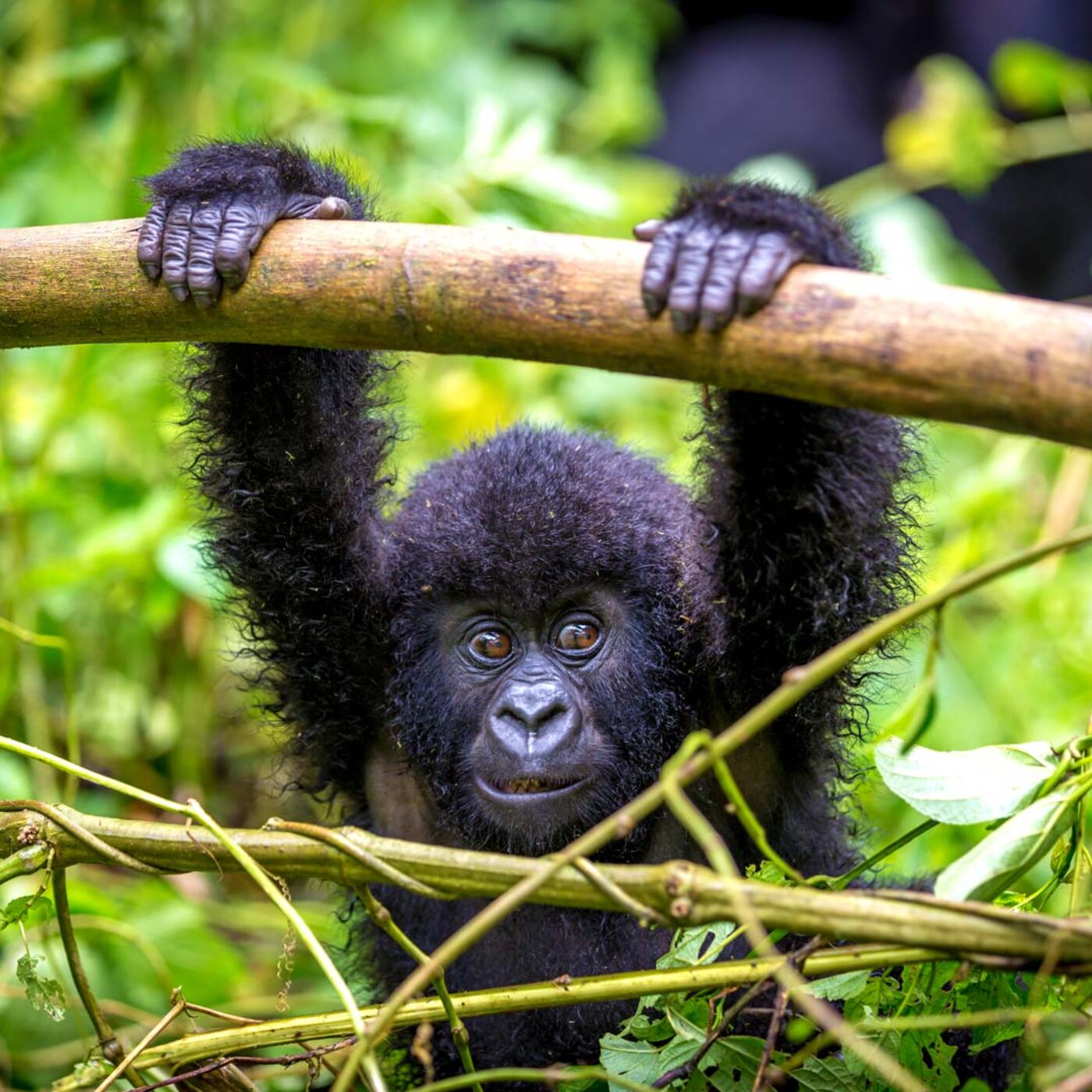
The day starts early for our last highlight in Uganda: the visit to the legendary mountain gorillas. After a thorough briefing by the ranger, our little expedition sets off. Equipped with bush knives, local guides guide us through thickets and lianas. At last, we encounter the eagerly sought-after gorilla family. Around 400 mountain gorillas live here in Bwindi, with another 600 in neighboring areas of Congo and Rwanda. This encounter makes every single kilometer of our adventurous journey through the “Pearl of Africa” more than worthwhile.
Important Uganda Information
Please always check your with your travel agent or go directly to the website of the Ugandan Embassy in your home country for up-to-date travel information.
Visa: Tourists need a Visa to enter Uganda. Tourist visas can be obtained upon arrival at the Entebbe International Airport.
Health:
Get comprehensive travel insurance covering global medical expenses. Check exclusions to ensure your activities are covered.
Check what vaccinations you may need for your trip at least eight weeks before you travel – you can get information about vaccinations from your travel agent or an International Health and Travel Centre.
Malaria is a year-round risk across Uganda. Protect yourself by wearing long clothing, using insect repellent on the skin, and sleeping under mosquito nets, especially after sunset.
Water
Drink or use only boiled or bottled water.
Local Emergency Numbers:
Police: 112
Fire department: 0800199299
Ambulance: 0800990000
Climate:
Uganda has a mostly tropical climate with two rainy periods: March to May and September to December. However, the northern quarter, lying outside the tropical zone, encounters just one rainy season from March to October.
Visa: Tourists need a Visa to enter Uganda. Tourist visas can be obtained upon arrival at the Entebbe International Airport.
Health:
Get comprehensive travel insurance covering global medical expenses. Check exclusions to ensure your activities are covered.
Check what vaccinations you may need for your trip at least eight weeks before you travel – you can get information about vaccinations from your travel agent or an International Health and Travel Centre.
Malaria is a year-round risk across Uganda. Protect yourself by wearing long clothing, using insect repellent on the skin, and sleeping under mosquito nets, especially after sunset.
Water
Drink or use only boiled or bottled water.
Local Emergency Numbers:
Police: 112
Fire department: 0800199299
Ambulance: 0800990000
Climate:
Uganda has a mostly tropical climate with two rainy periods: March to May and September to December. However, the northern quarter, lying outside the tropical zone, encounters just one rainy season from March to October.
Zimbabwe
Victoria Falls & Elephant Camp
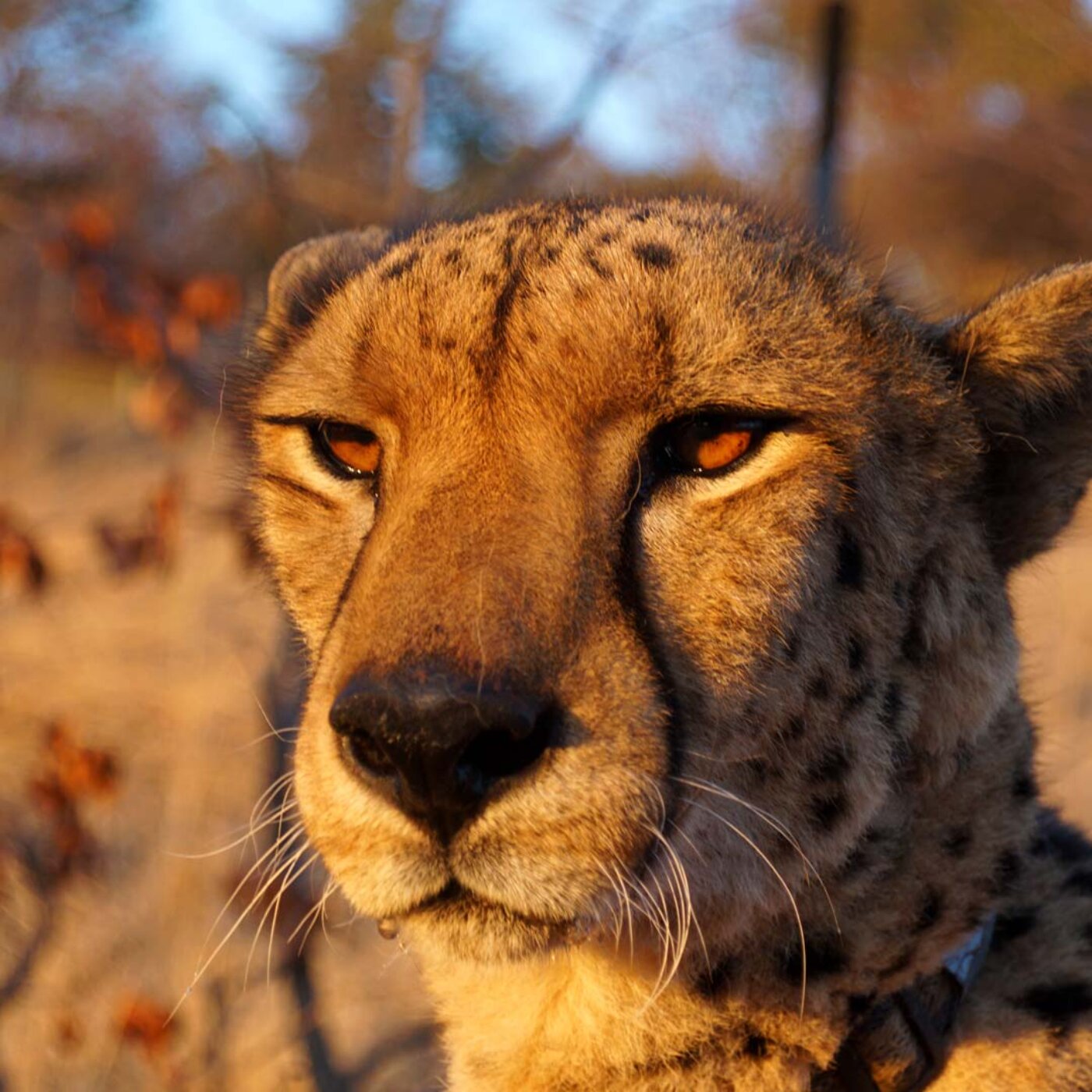
© Image: Henry Jedelsky
As the sun's first rays stretch across the Victoria National Park's horizon, they illuminate Victoria Falls' water wall, casting a radiant white glow. Our evening was spent at the cozy Elephant Camp, in a spacious tented bungalow with a terrace and private pool. Now we are already hiking on foot in the steppe near the camp. Our companions: two camp rangers and Sylvester, a seven-year-old adult male cheetah. Found as an orphan and raised by humans, he loves these long walks through the thorn bushes.After breakfast and a short drive, we settle into the historic Victoria Falls Hotel, which has exuded Victorian charm for a century and is renowned for its 5 o'clock tea tradition. Our afternoon is spent with a semi-tame lion pair, strolling alongside us and posing for photos.
Mana Pools National Park
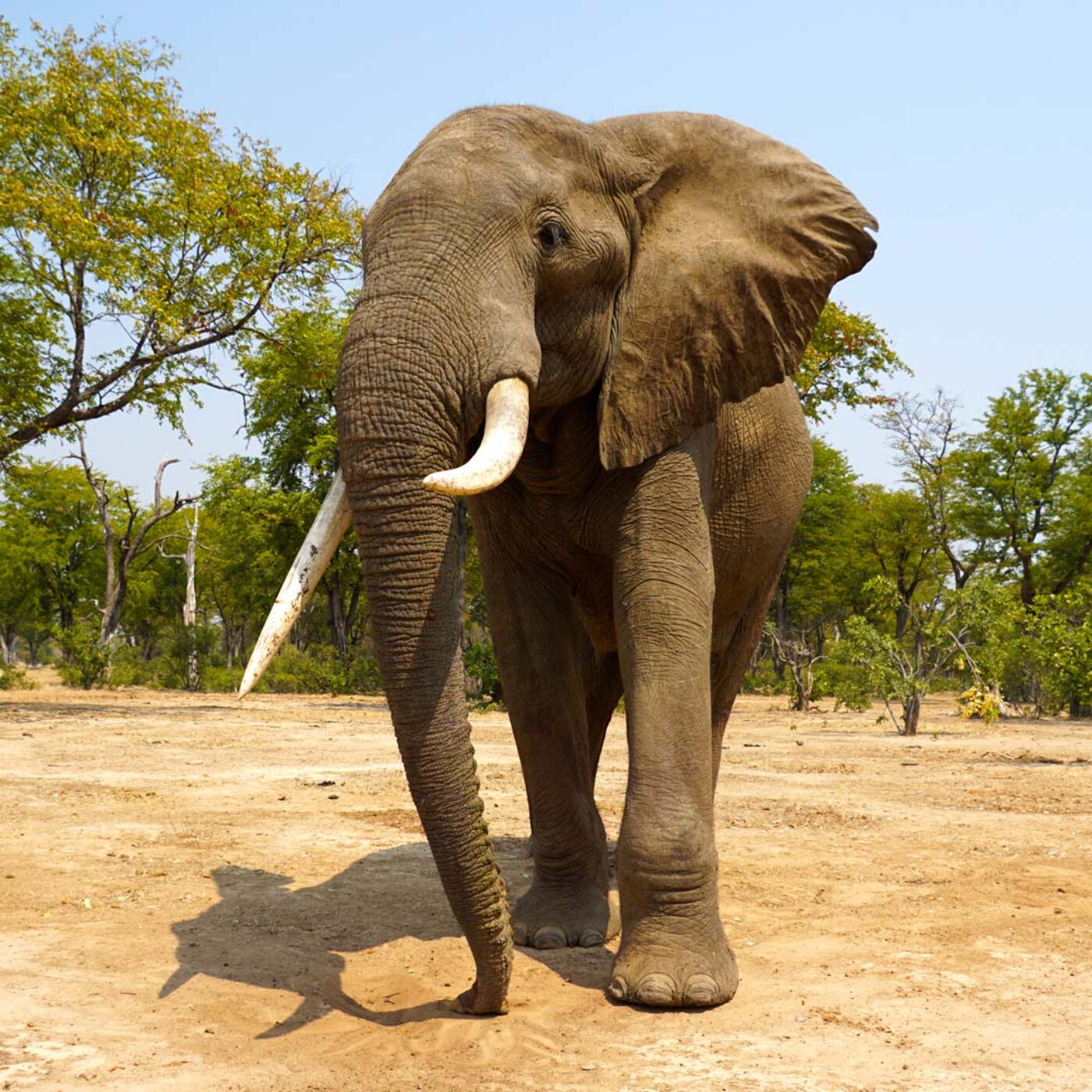
© Image: Henry Jedelsky
Early the next morning, a twelve-seater Grand Caravan-C 280 takes off from the new, modern Victoria Falls Airport. We fly along the Zambezi River to Mana Pools National Park in northern Zimbabwe on the border with Zambia. Around 3,000 elephants, around 80 lions and many of the now rare wild dogs live here. Countless impalas, kudus, waterbucks, baboons, and leopards inhabit the largest mopane dry forest in Africa, while Nile crocodiles and numerous hippos bask on the Zambezi's sandbanks. Our destination is the Goliath Camp. In the afternoon we are walking single file through the bush. As the sun descends behind the baobab and mopane trees, we encounter a large bull elephant using its trunk to pull down large branches from a tree. He isn't particularly interested in our group and comes closer. About half a meter in front of us, the bull elephant begins to nibble on a torn branch. Overwhelmed by this breathtaking moment, we remain in total silence. It was already getting dark before the elephant wandered off and we returned to camp. The next day we narrowly miss a lion attack on a herd of buffalo. We discover the injured male lion while his partner keeps an eye on the departing herd of buffalo. We see a pack of wild dogs hunting. A group of impala antelopes flee in a red-brown wave, pursued by the spotted pack. The hunt ends on the banks of the Zambezi when a young antelope becomes their prey.In the evening we indulge in superb South African steaks around the campfire at the camp. We then enjoy a shower under the impressive starry sky, as the shower area behind the tent is open to the top. The sounds of hyenas and hippos lull us to sleep.
Vundu Camp
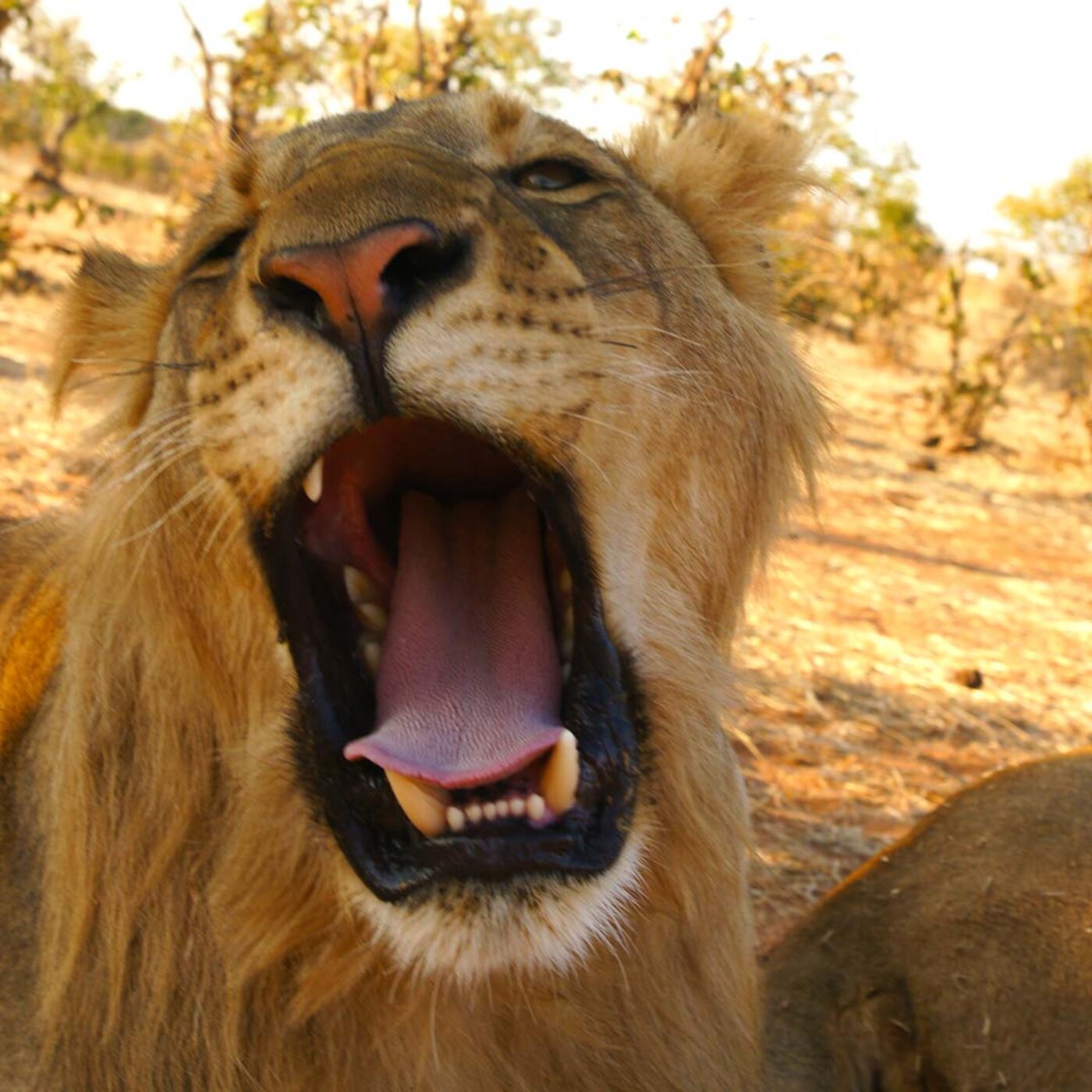
© Image: Henry Jedelsky
The next morning we meet a horde of around 120 baboons on the edge of a dry riverbed - it feels like scenes from the film "Planet of the Apes". We stay for two nights at Vundu Camp, situated right by the Zambezi River, featuring a large elevated main house and eight roomy tented bungalows. In front of the camp, we meet "Tusker" - a huge bull elephant. In Mana Pools camps, waking up early is common. After a cup of Rooibos tea, you're already at a significant spot in the vast and timeless African landscape. In the camps of Mana Pools, you get up very early so that after a cup of Rooibos tea you are ready for another sight of the immense, eternal African drama. So the sunrise finds us sitting on a termite mound, where we watch the return of a pack of wild dogs to their den with their puppies.The next day a small four-seater Cessna picks us up from the western airstrip. We fly over the huge Kariba Reservoir and the Matusadona National Park before landing in the well-kept town of Victoria Falls. We spent our last evening in Africa in the elegant Ilala Lodge. We enjoy an unforgettable candlelight dinner under the Southern Cross on the hotel terrace.
Zimbabwe Information
Please always check your with your travel agent or go directly to the website of the Zimbabwean Embassy in your home country for up-to-date travel information.
Visa:
Zimbabwe requires visitors to obtain a visa in order to enter the country. You may obtain a visa at the airport.
Health:
Get comprehensive travel insurance covering global medical expenses. Check exclusions to ensure your activities are covered. Check what vaccinations you may need for your trip at least eight weeks before you travel – you can get information about vaccinations from your travel agent or an International Health and Travel Centre.
Malaria is a risk in Zimbabwe throughout the year. Protect yourself by wearing long clothing, using insect repellent on the skin, and sleeping under mosquito nets, especially after sunset.
Water
Drink or use only bottled water.
Emergency number in Zimbabwe: 999
Climate:
Zimbabwe boasts a pleasant climate, with the central highveld plateau reaching around 28°C/82°F. Parks like Hwange and Zambezi are consistently warmer, while places like Mana Pools, Matusadona, and Gonarezhou get hotter, hitting 35°C/95°F.In the Wet season (November to March), expect afternoon rains. The Dry season (April to October) brings colder nights and mornings, dipping to 5°C/41°F. Days remain sunny and comfortable.
Visa:
Zimbabwe requires visitors to obtain a visa in order to enter the country. You may obtain a visa at the airport.
Health:
Get comprehensive travel insurance covering global medical expenses. Check exclusions to ensure your activities are covered. Check what vaccinations you may need for your trip at least eight weeks before you travel – you can get information about vaccinations from your travel agent or an International Health and Travel Centre.
Malaria is a risk in Zimbabwe throughout the year. Protect yourself by wearing long clothing, using insect repellent on the skin, and sleeping under mosquito nets, especially after sunset.
Water
Drink or use only bottled water.
Emergency number in Zimbabwe: 999
Climate:
Zimbabwe boasts a pleasant climate, with the central highveld plateau reaching around 28°C/82°F. Parks like Hwange and Zambezi are consistently warmer, while places like Mana Pools, Matusadona, and Gonarezhou get hotter, hitting 35°C/95°F.In the Wet season (November to March), expect afternoon rains. The Dry season (April to October) brings colder nights and mornings, dipping to 5°C/41°F. Days remain sunny and comfortable.
